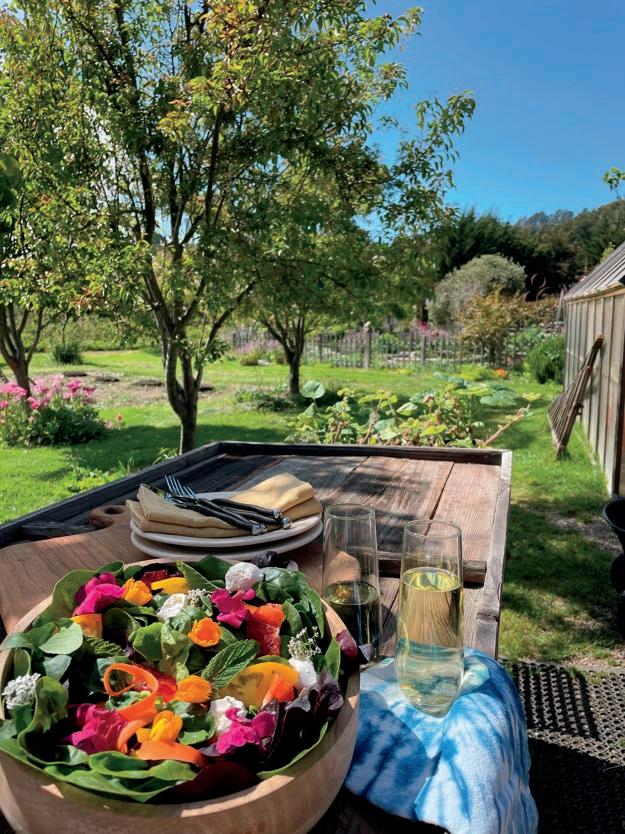


























What inspires you? Where do you find the inspiration to get going every morning and make life better for yourself, take care of loved ones and nudge the community forward?
Family motivates many people, or the wise words of spiritual leaders, while others find their muse in nature. Followers of Mother Nature are a high percentage of folks in our stunning corner of the planet, where a walk in the redwoods, a plunge in the waves or time spent tending the garden is often considered a religious experience.
We’re among the nature lovers here at Edible Monterey Bay—celebrating the return of summer produce to the farmers’ markets and rejoicing at the approach of the solstice—but what really inspires me is people.
Speaking with readers makes all the hard work of putting together this magazine worthwhile. That usually happens when I’m out on deliveries or at a big party with people I don’t know and sometimes when someone calls to subscribe “in person” by phone. People love and appreciate reading EMB and that keeps me motivated.
Equally important are the wonderful reporters and photographers on our team, and the graphic artists and sales reps behind the scenes. They continually delight me with their talents. Opening a new photo shoot on my computer is like Christmas morning. There are so few media outlets for talented people in our area that it’s a privilege to be able to provide one, and it gets me out of the garden and back to my desk every day.
Then there are the people we feature in this Summer issue, which is filled with inspiring individuals—all of them working in their own ways to improve the food system on the local, national and international levels.
We introduce you to a couple—better known for their outlandish Purple Party fundraisers— that is transforming a horse ranch out in Carmel Valley into an ecological paradise. You’ll also read the real life story of a farmer in Moss Landing who was encouraged to cultivate vegetables after traveling the world and starting a small garden in the highlands of Mexico.
You’ll meet new brewers, a cocktail artist and a real artist whose work revolves around the tables of the past. And we find out that living in our midst is a woman whose work, and Santa Cruz upbringing, is having a hugely positive influence on corporate food service across the country.
Also in this edition, we introduce Edible for Kids™—a new pullout section created in partnership with Barefoot Books, Inc. and filled with healthy cooking, eating and gardening tips for readers young and old.
One of the comments I hear most often from readers is how they find Edible Monterey Bay so positive and uplifting. It’s true, we are optimists at heart. While we don’t want to minimize the problems facing our society, there is plenty of coverage of those issues in other media. We prefer to use our magazine to create a beautiful space with stories of local people who are working to make things better.
We hope it brings you some inspiration this summer!
Deborah Luhrman Publisher
EDITOR AND PUBLISHER
Deborah Luhrman deborah@ediblemontereybay.com 831.600.8281
FOUNDERS Sarah Wood and Rob Fisher CONTRIBUTING EDITOR Mark C. Anderson
COPY EDITOR Doresa Banning
LAYOUT & DESIGN Matthew Freeman and Tina Bossy-Freeman
AD DESIGNERS Bigfish Smallpond Design Savanna Leigh • tracysmithstudio • Zephyr Pfotenhauer
CONTRIBUTORS
Jeff Bareilles • Emily Beggs • Caroline Chambers
Jamie Collins • Margaux Gibbons • Doriana
Hammond/West Cliff Creative • Martin Hoellrigl • Kathryn McKenzie • Laura Ness • Zephyr Pfotenhauer • Geneva Rico • Chris Schmauch Laura Sutherland • Michael Troutman • Randy Tunnell • Amber Turpin
ADVERTISING SALES
ads@ediblemontereybay.com • 831.600.8281 Shelby Lambert shelby@ediblemontereybay.com Kate Robbins kate@ediblemontereybay.com Aga Simpson aga@ediblemontereybay.com
DISTRIBUTION MANAGER

Mick Freeman • 831.419.2975
CONTACT US:
Edible Monterey Bay P.O. Box 487 Santa Cruz, CA 95061 ediblemontereybay.com 831.600.8281 info@ediblemontereybay.com
Edible Monterey Bay is published quarterly. All rights reserved. No part of this publication may be used without written permission of the publisher. Subscriptions are $28 per year at ediblemontereybay.com. Every effort is made to avoid errors, misspellings and omissions. If, however, an error comes to your attention, please accept our apologies and notify us. We also welcome letters to the above address. Thank you.
to savor the extraordinary.
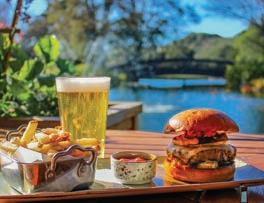
In Monterey County, some experiences are best enjoyed at a slower pace. It’s easy to get lost in a stunning vista, the creativity of a dish, or a good conversation with great friends. So, come explore the flavor of this place. At your own speed. SeeMonterey.com/Now

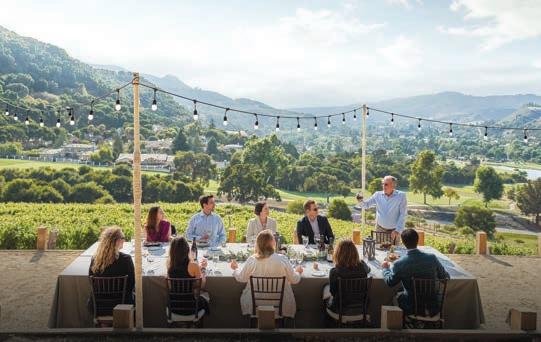

 BY KATHRYN MCKENZIE PHOTOGRAPHY BY MICHAEL TROUTMAN
BY KATHRYN MCKENZIE PHOTOGRAPHY BY MICHAEL TROUTMAN
It all started with gifts of silverware from her grandmother, at a time when she was too young to realize the significance of such items. But she treasured them nonetheless.
For Leslie Lewis Sigler, it isn’t just about owning these precious mementos—it was the start of what would become her artistic inspiration.
The Soquel artist has become known at galleries across the country for her still-life paintings of antique serving ware, a simple subject that becomes infinitely more complex as Sigler explains how she creates her work.
During the pandemic, the thoughts and emotions behind each piece deepened and evolved as she concentrated on her work during long lonely days, separated from her extended family in Texas.
“I felt this deep longing to gather with my family, but I couldn’t,” recalls Sigler. “I grouped these objects that represented that longing, that feeling of wanting to join with family around the table again.”
In her artist’s studio, drawers hold a motley assortment of silver plated pickle forks, berry spoons, salad servers and butter knives, all pieces that serve as potential subject matter for her paintings.
She holds up a finely made piece with a serrated edge and intricate design, which she thinks is a macaroni server. For some of the beautifully crafted serving ware, she’s not 100% sure of the exact use. Amazingly, there were very specific uses assigned to some pieces, such as the tomato server, the nut server and a spoon specifically made for dusting powdered sugar on pastries or fruit. “You tap it,” says Sigler, for the sugar to fall just so. Another rare piece she received from her grandmother was a butter chiller—a round dish with a hidden compartment for ice to cool the butter above.
Sigler has kept items not only from her own family and her husband’s family, but also over the years, she acquired pieces from friends who gave them to her “because they know I paint silver.” She also bor-
Her hyper-realistic oil paintings start out as photographs that she sketches on board. The finished art (top right) is alive with reflections and shadows.




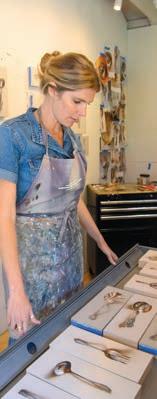

rows items occasionally from Hall’s Surrey House Antiques in Soquel with the owner’s permission, and he’s also been helpful in identifying some of the oddball items.
Many of these unique serving ware designs were created in the late 1800s and early 1900s, a nod to a more genteel time when the upper middle class put a high value on entertaining in just the right way with the most precise implements for a variety of fancy foods.



These days, there’s a more minimalist approach to setting a table, so this era of elaborate serving pieces has passed. But Sigler’s fascination with them keeps alive a telltale sign of that time.
“Their use is long gone, but I’m honoring their history,” she says.
Sigler starts her process by arranging and rearranging serving ware pieces in a variety of ways. She often paints individual portraits of many of the more obscure pieces, the ones where you have to guess their function.
Now, she has entered a phase where she groups more ordinary pieces in different ways, hinting at familial relationships between them. There’s one she recently completed of 10 forks of different shapes and sizes, some polished and others tarnished from age. And there is the series of paired items, usually a large serving spoon and fork, typically complementary but not exactly alike. Sigler calls these “brothers and sisters.”
When she finds combinations of implements that she likes, she photographs them, then draws a study and paints them in oils on board. Sigler deliberately keeps the backgrounds extremely simple, putting the entire focus on the serving ware. The painted still lifes are very close to photore-
alism, showing the reflections of colors and sometimes reflected items in the studio environment, such as windows or a glimpse of the artist herself.
She starts with a monochromatic painting and then adds color in light and dark layers. Sigler thinks of the pieces as people, and comes up with intriguing names for her paintings, such as “The Mystic” and “The Dilettante.”
Originally from the hill country of Texas, Sigler studied painting at the University of Texas at Austin, and moved to Soquel with her husband four years ago. Her work is represented by galleries in Texas, South Carolina and Connecticut, as well as at Curated By The Sea in downtown Santa Cruz. She’ll have a solo exhibition at the Sullivan Goss art gallery in Santa Barbara from July 1–Aug. 22.

With two young sons and a busy painting schedule, Sigler is also finding time these days to reconnect with family members whom she hasn’t seen since before the pandemic. She has a new appreciation for those relationships, and that can be seen in her art.
“The root of these pieces is family, gathering and bringing people together,” she says.

Works by Leslie Lewis Sigler • Curated By The Sea, 703 Front St., Santa Cruz curatedbythesea.com • 408.250.2224
Kathryn McKenzie, who grew up in Santa Cruz and now lives on a Christmas tree farm in north Monterey County, writes about the environment, sustainable living and health for numerous publications and websites. She is the co-author of Humbled: How California’s Monterey Bay Escaped Industrial Ruin.
“Their use is long gone, but I’m honoring their history.”


 BY LAURA NESS PHOTOGRAPHY BY RANDY TUNNELL
BY LAURA NESS PHOTOGRAPHY BY RANDY TUNNELL
Turning onto Hobson Road from Highway 101 in Greenfield, Scheid is the first property you encounter. It’s also pretty much the only one. The street number is 1972 and that’s no accident. That’s the year patriarch Al Scheid planted the first vines here. When you’ve been on a property as long as the Scheid family has, apparently you can pick any number you want.
Heidi Scheid, executive vice president of Scheid Family Wines, says her father—who turned 90 in February and is now chairman of the board—started the vineyard to make money for his investment partners. “He is always engaging with us, ready to contribute. He also tells us to learn something new every day!” He’s made good on his objective.
From that very first planting, Scheid’s holdings expanded to include more than 3,000 acres of vineyards that stretch the length of the Salinas Valley, covering four different climate zones. “We have estate vineyards in each of them. Riverview and Isabelle’s Vineyard, where we grow pinot noir and chardonnay, are in Region 1,” says Heidi. “Greenfield, Arroyo Seco, is Region 2, where we have pinot noir, chardonnay, sauv blanc and albarino. Further south is Region 3, where the bigger reds are grown: merlot, cabernet sauvignon and syrah, which like the long warm days. In Hames Valley, where there is a huge diurnal temperature difference, 50 to 60 degrees, we grow petite sirah, petite verdot, cabernet sauvignon and tannat.” Quite the portfolio. And it’s all in Monterey County.
For the first 30 years of the operation, Scheid sold 100% of the grapes it grew.
exciting and posh tasting room on Cannery Row. After a few years, they moved it to a more conducive setting in Carmel, where it thrives with its breadth of offerings.
Scheid has grown to producing more than 700,000 cases of wine annually under various labels, many distributed nationally. It also provides grapes, custom crush and other wine services to a broad range of clients.

In 2002, winemaker Dave Nagengast, a Fresno State grad and former discus thrower, came aboard the good ship Scheid. It would never be the same. It is safe to say that he was fundamental in transforming the operation into something massive, yet oh so shipshape. He was tasked with designing and building a winery that could grow exponentially with the company. The result is a magnificent 85,000-square-foot steel fermentation building, that cost $80 million to build and can accommodate 30,000 tons of grapes, which translates into a capacity to handle more than 2 million cases of wine a year.
Scott, Al and Heidi Scheid toast to the wine company’s golden anniversary. Opposite page, the wind turbine that powers the entire winery operation and 125 homes.

“We were not making any of our own wine,” says Heidi. “In 1989, we made 50 cases. That was the start. In 1997, we opened the Greenfield tasting room. By 2011, we had 4,000 cases of our own wine and decided to focus on growing our own brands.” They also opened what was then the most
The state-of-the-art winery looks like a scene from Star Wars, gleaming with polished steel and a level of cleanliness you would desire from a facility that handles food. After all, wine is food. The scale of the operation is mind-boggling. It is a marvel of custom machined tanks with special slides for must removal, glistening alumi-
As Scheid hits the half-century mark, it has gone from grapes alone to a vertically integrated grape-toglass operation.
num gangways, miles of rubber hoses for moving wine, punch down devices and filtering machines, all on wheels, and all designed to scale up as volume grows.
In 2005, Scheid constructed a totally separate 8,000-square-foot microwinery on site to craft the higher-end Scheid Vineyards wines. “This is a winery within a winery that produces the wines we sell in the tasting rooms,” CEO Scott Scheid tells us. “We are planning to build a completely covered and expanded crush pad, complete with ample lighting for those midnight picks.”

As Scheid hits the half-century mark, it has gone from grapes alone to a vertically integrated grape-to-glass operation, inventing new brands yearly to target segments of the market that are not yet filled. That has turned it into a big and complex global company.


Brands like Metz Road, with its succulent chardonnay and pinot noir that are actually made right in the vineyard in a specially designed fermentation trailer, appear on highend restaurant lists. Hive & Honey, a slightly sweet gewürztraminer, is a big seller at Kroger, while District 7 appears on grocery shelves pretty much throughout the Central Coast. Heidi’s current passion is the two-year-old brand called Sunny with a Chance of Flowers, a series of low alcohol, low calorie wines in brilliantly attractive packaging, widely available in retail stores. Keeping its brands fresh, inventive and market ready is part of what fuels Scheid’s success; the other part is a strong commitment to sustainability.
“Sustainability was important to Al from day one,” says Heidi. “He took his role as an environmental steward seriously, as well as giving
back to the community. It was critical to become Certified Sustainable, which we have been since 2014. Our 85-acre White Flower Vineyard was certified organic in 2020, and most of our estate vineyards are farmed using organic methods.”

Perhaps the most visible symbol of the company’s commitment to sustainability is the 400-foot tall wind turbine that provides 100% of the power at the facility, generating enough excess energy to power 125 homes in the community. Harnessing the wind has proven a huge win.

As much as Scott loves to talk about the turbine, though, he also enjoys pointing out little bits of history on the property, like the brass replica of a vineyard worker carrying a basket of grapes that graces every Scheid label, by artist Danny Piffero of Mendocino Metals.
“And this fence,” he says, pointing to a wall of tightly spaced slim wooden slats that separates the winery production area from the tasting room and offices, “this is made entirely of the grape stakes we originally used to plant the first vines here. How’s that for recycling?”
Fittingly, the tag line that adorns each wine label and each piece of merchandise remains, “It is the grapes.” As true now as it was back in 1972.

Santa Cruz woman helps big business work toward a sustainable food system STORY AND PHOTOGRAPHY
BY JEFF BAREILLESSanta Cruz native Maisie Ganzler’s calling as an environmental and social activist wasn’t part of her original career plan, but it actually dates back farther than she remembers—back to when she was an infant.
As the story goes, before Wilder Ranch was a state park, it was a self-sustaining dairy farm and cattle ranch. When the Wilder family couldn’t make ends meet running the property, it was sold to a land development company that planned to build luxury housing, a golf course and shopping centers there. In protest, Ganzler’s parents and other concerned Santa Cruz residents formed Operation Wilder to block the development.
Baby Maisie also participated, though unknowingly. During public hearings to decide Wilder Ranch’s fate, her mother openly breastfed her new daughter as a disruption strategy, an illegal act in California until 1997.
Ganzler describes her parents as “bohemian.” They worked in the nonprofit sector and partied with counterculture types at their downtown Victorian-style home. While attending Santa Cruz High, she worked at the Dolphin Restaurant on the Municipal Wharf and, like most kids, wasn’t totally on board with her parents’ lifestyle. Her act of rebellious angst was to leave Santa Cruz and attend Cornell University’s prestigious School of Hotel Administration. Her ultimate act of de-
fiance was to pursue a career in the for-profit business world.
“I wanted to focus on restaurant service, not social service,” says Ganzler.
One year after graduating, Ganzler joined Palo Alto-based Bon Appétit Management Co. (BAMCO), an on-site restaurant firm offering full food service management to corporations, museums, colleges and universities, and part of the multinational Compass Group.
“I set my sights on Bon Appétit after reading an article in a trade magazine about the company’s innovative restaurantstyle approach to food service,” Ganzler recalls. BAMCO’s cutting-edge approach in 1994 was serving seasonal, locally sourced food. The job allowed her to return to Santa Cruz, where she now lives just a few blocks away from where she grew up. Ganzler loves being able to walk to visit friends, go to movies or dine out.
As vice president of strategy and brand officer at BAMCO, Ganzler oversees the food service company’s supply chain and purchasing standards. Together with CEO Fedele Bauccio she leads the operation of 1,000-plus client sites across the U.S., at which each kitchen prepares meals from scratch, emphasizing seasonal ingredients sourced locally. In addition, each chef has their own network of direct supply relationships within their respective communities.
The names of some of the clients she is charged with may ring a bell. Google, Oracle, Twitter, the Getty Center and UCSF are all on her plate. In 2019, BAMCO served 250 million restaurant-quality meals for clients in 33 states.
Conscious or otherwise, Ganzler admits that some of her parents’ beliefs took root.
“The value my parents put on community seeped in somehow,” she says with a laugh. “I only cringe slightly when I hear myself quoting my mother’s frequent invocation of the Buddhist Eightfold Path and saying my work at Bon Appétit is ‘Right Livelihood.’”
As a result, BAMCO operates very differently to other national food service companies.
“In order for us to protect our planet, resources and communities, sustainability must cross all lines—geographic, political, racial and economic,” Ganzler says.
A prime example is its Farm to Fork program, which she was instrumental in creating in 1999. It was the first national program by any restaurant food service company that committed to purchasing at least 20% of all food served from purveyors located within 150 miles of its restaurants and cafés. That translates to 50 million meals a year that support small, independently operated organic farms, butchers, bakers, fisheries, dairies, hatcheries and artisan makers.
“I take great pleasure in pushing the company forward and proving that a for-profit business can act with both a warm heart and a scientific mind,” Ganzler says.
Other practices she initiated at BAMCO include: launching nationwide programs and policies that forbid the use of antibiotics or growth hormones in meat and poultry products; switching to Certified Humane
ground beef; phasing out pork raised in gestation crates; requiring the purchase of superficially imperfect but entirely edible fruits and vegetables; mandating the exclusive use of Certified Humane and cage-free eggs; and implementing programs to reduce carbon emissions, while raising awareness about the many ways that food production and greenhouse gases are linked.
Also, she has joined farmworker marches for rights, respect and fair working conditions, followed by the creation of BAMCO’s code of conduct, which demands the company’s suppliers ensure fair treatment and wages for all farmworkers. At the same time, BAMCO collaborated with United Farm Workers and Oxfam (a global organization that fights inequality to end poverty and injustice) to create the Equitable Food Initiative—a program with rigorous standards for labor practices, food safety and pest management.
BAMCO’s innovations and initiatives have rippled through the food service sector as competitors try to keep up, multiplying its impact over and over.
COVID halted all food service at BAMCO’s clients’ sites. Imagine serving 250 million meals one year and the next, all 1,000-plus venues close, reopen, close and reopen. Yet, the company remained agile amidst the chaos, anticipating how its services and operations would need to evolve and adapt to the new normal.
“During the ‘downtime,’ we were focused on many different areas that help us make decisions that meet our standards or meet certain environmental goals,” says Ganzler.
Not surprisingly, BAMCO chose to focus on technology by building new tools like its app-
A scarecrow at Wilder Ranch State Park— which Ganzler, her parents and Santa Cruz activists helped save from development in the 1970s.

enabled ordering system, Curated, that allows guests to pre-order meals to their specific dietary needs, may they be vegetarian, vegan or around allergens. Then by using some of their closed kitchens, they can prepare and serve these meals efficiently and effectively.
Another new technology is its Food Standards Dashboard, an internalfacing tool that helps chefs make menu decisions that meet company food standards and environmental goals. The dashboard also has the World Resources Institute’s carbon calculator embedded in it. With it, chefs can see the carbon impact of their menus and make pro-planet choices about what they prepare, such as lowering the amount of beef and cheese used or raising the amount of plant-based protein used. To address food waste, BAMCO built a waste tracking app called Waste Not.
Ganzler’s involvement in sustainability isn’t limited to her work at BAMCO. She also sits on the board of directors of Air Protein—a company that’s developed a technology that harvests protein out of thin air! Using fermentation tanks, Air Protein combines elements from the air— carbon dioxide, oxygen and nitrogen—with water and mineral nutrients in a process similar to making wine or yogurt. Renewable energy powers its production process, which uses microbes to convert CO2 into amino acids. The final yield is a protein-rich flour that can be used just like soy or pea flour.
When asked what sustainability practices individuals and small businesses can follow at home or on the job, Ganzler urges: “Start small and ask yourself, ‘What things can I do that will lead to many different good outcomes?’ Find out what’s produced nearby, how it’s made, when it’s in season. Reduce beef and dairy consumption—greenhouse gas emissions caused by animal-based food production come mostly from beef and dairy production. These actions are simple, manageable, effective and impactful places to start.”


From rebellion to revolution, from questioning the status quo as a teenager to creating calculated business strategies that ensure an economically and environmentally sustainable food system across the country, Ganzler's path has paid off in everybody's favor.

Jeff Bareilles is a Santa Cruz-based artist/photographer/writer who explores the worlds within and around him, through actions, images and words.


“I take great pleasure in pushing the company forward and proving that a for-profit business can act with both a warm heart and a scientific mind.”
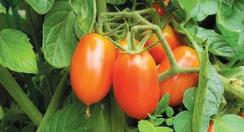

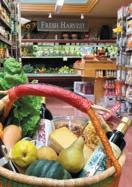
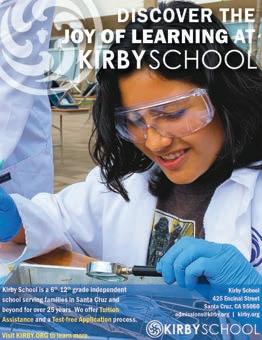



Raspberries remind me of my aunt, who would bring a big bowl of summer fruits with her when she visited, because she knew I preferred berries to sweets. Whenever raspberries were in the bowl, I’d put them on the tips of my fingers before I ate them. My son Ivan is now the fruit bat of the family, and I’ve caught him doing the same thing.
Raspberries—botanically known as Rubus idaeobatus are perennial cane berries in the rose family. Their name comes from the 15th century word raspise which meant
“sweet, rose colored wine.” When you eat a raspberry off the vine you pull the fruit from the center etaerio (the part that connects the fruits like an inner stem) and it stays attached to the plant; that’s the reason kids can stick their fingers in them! Because of this, raspberries are softer and more delicate than blackberries. When you eat a raspberry you are ingesting a hundred or more individual drupelets, the scientific word for tiny aggregate fruits that contain edible seeds.
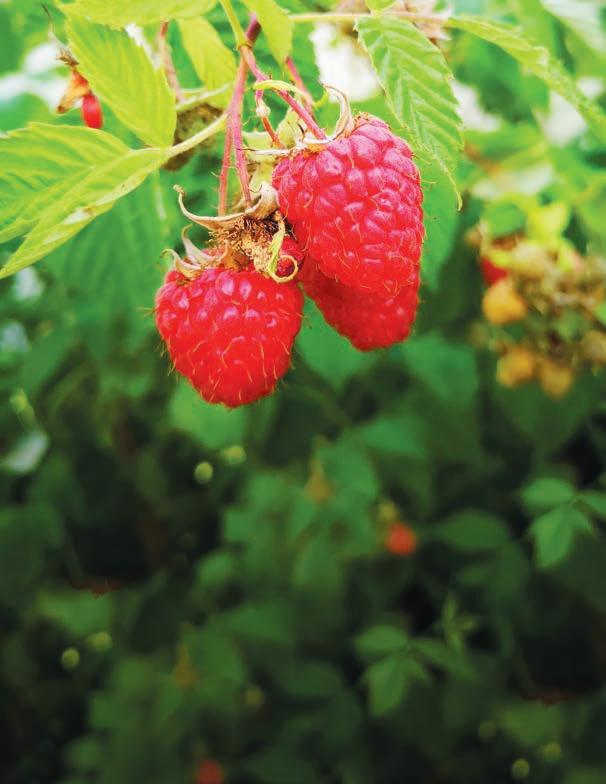

Raspberries originated in Asia and North America, and there are records of these jammy jewels being wild foraged in the foothills of Turkey prior to the fourth century. A Roman agronomist documented that they were domesticated and found in gardens just after that time, and seeds were found at Roman forts in Britain, indicating that the Romans were responsible for the spread of cultivation throughout Europe. Before this time raspberries were only eaten by royalty and used as pigment, to add juicy red color to paintings and manuscripts.
When European settlers arrived in America they found Native Americans were already eating and storing wild raspberries as a food source, and using the parts of the plant for medicine. The leaves, bark and roots were valued for various digestive ailments. Indigenous peoples in the Pacific Northwest, Canada and Alaska called them salmonberries because the tribes enjoyed them alongside salmon roe, quite the nutrient dense combination. They also made drinks out of raspberries and added them to meat dishes and soups. They were considered such an important source of nutrients that raspberries were dried and pressed into thick cakes with dried buffalo meat and tallow. These original protein bars, called pemmican, were very nutrient dense and high in
calories, and could provide sustenance through lean winter months or long distance travel. Pemmican did not spoil because the meat and raspberries were preserved in fat.
These days the West Coast is the largest producer of red raspberries. Washington leads with 70% of the production in frozen and processed fruit, followed by Oregon and California, which grow mainly for the fresh market. There are currently 10,000 acres in production in California. Acreage has been slowly increasing in Santa Cruz and Monterey counties where the strawberry market has become saturated. Raspberries are now the second most valuable crop in Santa Cruz County and third most important fruit crop in Monterey County, after strawberries and wine grapes. The Monterey Bay area is a perfect place for growing fresh market raspberries practically year-round due to rich soil, plenty of sun and very little precipitation that can ruin the fruit. A good crop can yield 4,000 pounds to the acre each season, and the plants can be left in the ground for several years, unlike strawberries that are re-planted annually.
Raspberries can be found locally starting in mid-April through November. Varieties that ripen at different times are grown, but the best tasting raspberries are those harvested in the

summer when the sun boosts sugar content.
Javier Zamora, owner of JSM Organics, tends 12 acres of raspberries in Watsonville. He grows four varieties of red raspberries as well as Anne (yellow) and double gold (blushyorange). His favorite to snack on is Anne because they are very fragrant and sweet with a hint of a tropical fruit taste. He says the double gold are less sweet than Anne but have a mango essence to them. You can buy his raspberries at the Thursday downtown Carmel Farmers Market and by U-Pick with an appointment during the months of June, July and August when the fruit is most abundant.
Prevedelli Farms and JCG Farms both also grow organic raspberries in Watsonville. Prevedelli can be found at the Downtown Santa Cruz Farmers Market on Wednesdays with raspberries, blackberries, ollalieberries and boysenberries.
In Carmel, Earthbound Farm was founded as a 2.5-acre organic raspberry farm in the 1980s and still has rows of raspberries to visit behind the farm stand on Carmel Valley Road.

New cultivars have come out that have stronger canes and need less staking, and some new varieties are even thornless, so be sure to look
for those varieties when considering planting raspberries in the garden. Bees will help pollinate the raspberries and love the nectar the raspberry flowers produce, so there are dual benefits to growing them in the garden. They can be grown from a cutting, a plug plant or by digging up suckers that pop up next to the mother plant.
The best time to plant is late fall to early spring. Make sure to locate a spot with full sun and nice soil that has been worked well and has no hard areas where roots will struggle to spread. Each plant should be spaced 24 inches apart with 3 feet between rows. When planting canes, be sure that the hole is wide enough to accommodate all of the roots when they are spread out, however the main roots only need to be 2 inches below the ground. Cover well with soil and top with compost. Water often to establish the root system. Once the canes start leafing out, apply a slow release organic fertilizer that is high in nitrogen, and when the flowers and fruit start, apply some fish or kelpbased fertilizer, calcium and potassium.
Be sure to harvest all the raspberries, even the bad ones, and remove them from the area to avoid fruit flies that can lay their eggs inside the berries and ruin all the upcoming fruit. Mites can also be problematic; the best thing to do is prevent them by reducing dust in the growing area and keeping the plants healthy and strong. The closer you are to the coast, the more issues you might have with fungus from the evening mist that occurs and can rot ripe fruit. If this is an issue, covering with plastic hoops will protect the plants.
Like most fruits, raspberries are mostly water, but due to their tiny seeds, the fiber content is one of the highest in any fruit or vegetable at 6% per weight. They are low in sugar, high in vitamin C and manganese, and contain anthocyanins and carotenoids—both antioxidants which combat free radicals in the body that can cause disease.
I love to make raspberry leaf tea for both the health benefits and the flavor, which is similar to black tea. Red raspberry leaf tea is good for pregnancy and labor—it helps to induce labor and boost milk supply. The leaves are delicious hot or cold and combined with other herbs or fresh raspberries.
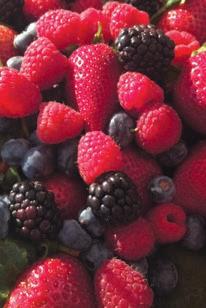

Raspberries add intense flavor to beverages, salad dressings and alcoholic beverages such as framboise, a Belgian lambic fruit beer, and Chambord, a French raspberry liqueur.

Chambord was inspired by a liqueur made in France that was given to Louis XIV during a fancy meal during his visit to Château de Chambord in Loire Valley, France. It is made by infusing red and black raspberries in spirits for several weeks. Then fresh berry juice is pressed and combined with the infused spirit and vanilla, citrus peel, honey, herbs and cognac.
You can simply pop some raspberries in vodka or any other clear spirit to get a flavored, yet lighter raspberry-infused alcohol. Of course you don’t need alcohol to enjoy an infused drink with raspberries. I like to pair thyme with raspberries and make lemon or limeade. To do so, make simple syrup using equal parts water and white sugar, add the
thyme once boiling, turn down the heat to simmer and let it infuse for 20 minutes then strain. In a separate pot, cook raspberries in a little water to cover them until they juice out to a liquid. Let cool. Next, add the juice of a few Meyer lemons or limes, add a splash of thyme simple syrup with the raspberry juice. Add the syrup slowly until you reach the desired sweetness. If you want it tarter, add more citrus juice. Pour over ice, or better yet, make popsicles and add some whole fresh fruit to them. You can also add whole raspberries to rosé and make wine pops!
Jamie Collins is the owner of Serendipity Farms. She hosts U-Picks and a Friday Farm Stand at 26500 Val Verde Drive in Carmel, and attends farmers’ markets in Carmel and Santa Cruz, where you can find her fresh organic fruit, vegetables, herbs and flowers. Find out what is being harvested @fabulous_serendipity_farm.


The subtle citrus notes in the filling of this simple homestyle favorite make the berry flavors sparkle. Blueberries hold their shape and strawberries are naturally sweet, but any combination of berries works. This crisp really doesn’t need adornment, but if you can’t resist, a dollop of crème fraîche adds a pleasant tart contrast to the sweet fruit. And of course, whipped cream or ice cream are also delicious!
6 cups assorted organic berries
Zest of 1 orange
Zest of 1 lemon
1 tablespoon fresh lemon juice
2 tablespoons orange -flavored liqueur, such as Cointreau or Grand Marnier
½ cup granulated sugar
2 tablespoons cornstarch
¾ cup unbleached all-purpose flour


½ teaspoon allspice
¼ teaspoon salt
½ cup dark brown sugar, firmly packed




2 tablespoons granulated sugar

6 tablespoons unsalted butter
½ cup old-fashioned rolled oats (not instant)



1 cup crème fraîche
Position a rack in the center of the oven and preheat to 375° F.
Make the filling: Place the berries, orange zest, lemon zest, lemon juice and liqueur (if using) in a large bowl.
Place the granulated sugar and the cornstarch in a small bowl and whisk to combine. Add the sugar mixture to the berries and toss gently to combine. Transfer the berry mixture to a shallow 2-quart baking dish.
Make the topping: Place the flour, allspice, salt, brown sugar, granulated sugar and butter in a medium-sized bowl. Using your fingers, blend in the butter until it’s in pieces roughly the size of peas. Add the rolled oats and stir to combine. Sprinkle the topping over the berries, but don’t pack it down.
Bake the crisp until the fruit juices bubble up around the edges of the baking dish and the topping turns golden, 30 to 35 minutes. Let the crisp cool slightly before serving it warm with crème fraîche, if desired. Serves 8.
From Food to Live By: The Earthbound Farm Organic Cookbook by Myra Goodman. More recipes using organic fruits and vegetables can be found at earthboundfarm.com/recipes.
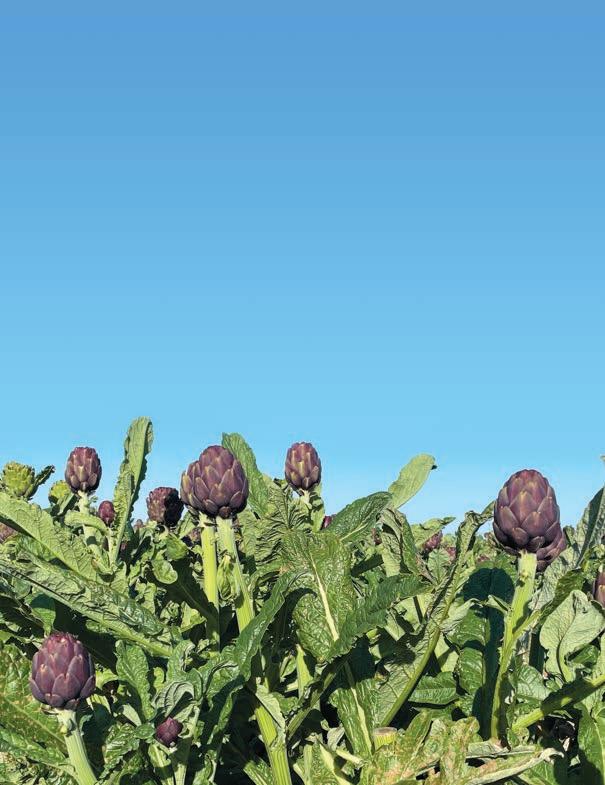
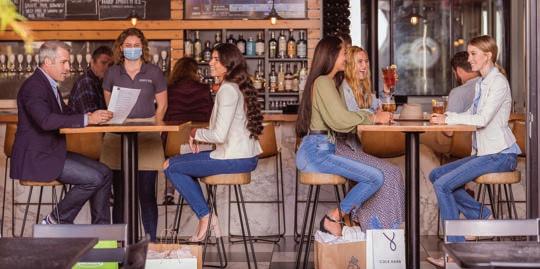

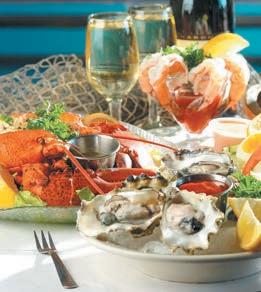


Thursday
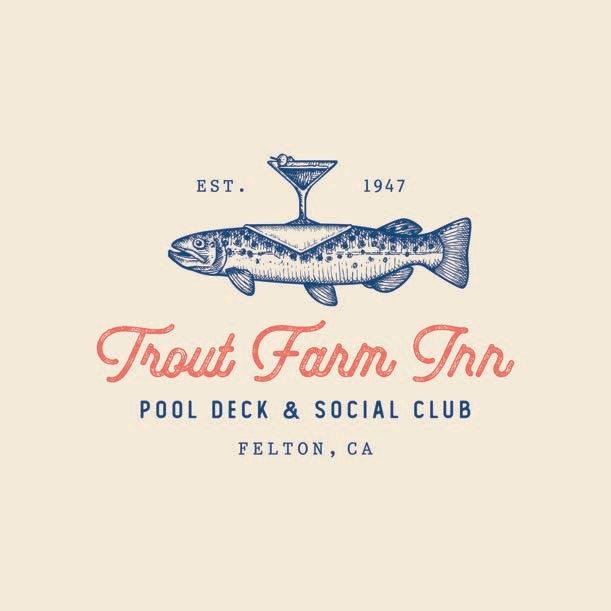
Jacks Monterey is poised to provide a refreshing experience with a philosophy centered on the globally-inspired traditions of California Cultural Cuisine, emphasizing local ingredients, high-quality seafood, and more.
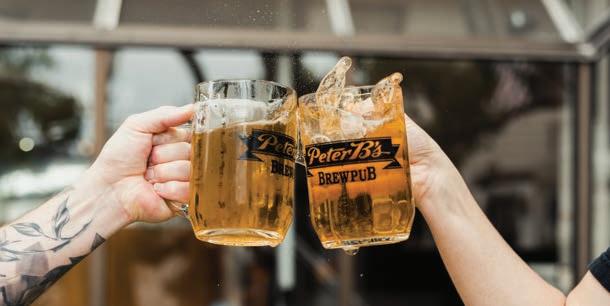
• seasonal menu with locally sourced ingredients

• handcrafted cocktails & award-winning wine list
• pet-friendly outdoor terrace with fire pits
• offering breakfast, dinner & space for private events
LOCATED INSIDE THE PORTOLA HOTEL & SPA COMPLIMENTARY SELF OR VALET PARKING TWO PORTOLA PLAZA | MONTEREY, CA | (831) 649-7830 JACKSATPORTOLA.COM |
What to make when a day at the beach or a stroll along the Monterey Bay leaves you hungry
BY CAROLINE CHAMBERS AND MARTIN HOELLRIGL PHOTOGRAPHY BY CAROLINE CHAMBERS AND CHRIS SCHMAUCHWe all love cheap and cheerful seafood eaten with your feet in the sand, but what if the occasion or your taste buds call for something a little more sophisticated? Stretch your cooking skills with these flavorful seafood-based recipes.


Courtesy Caroline Chambers
Grits are a staple at breakfast, lunch and dinner in my home state of North Carolina. If you’re not familiar, grits are dried corn that has been ground up, then soaked and cooked until it blooms into a creamy porridge. I cut out the drying process with these fresh corn grits—grab the freshest corn you can find at the farmers’ market and grate it on the largest hole of your box grater. Over heat, the natural starches and sugars in the corn turn it into the most wonderful bowl of fresh corn “grits” you’ve ever had. They make a delicious side dish for any summer meal, especially when served with Cajun Butter Shrimp and Red Peppers for a fun spin on the classic southern meal, Shrimp ’n Grits.
8 ears corn on the cob, husked 1/3 cup whole milk or almond milk
Kosher salt
Black pepper 2 tablespoons butter, cubed (optional)
There are two ways to make fresh corn grits. To make them using a food processor: Cut the kernels off of the corn on the cob and place in a food processor with 1 tablespoon of the milk. Pulse 5 to 10 times until wellground. Transfer to a large skillet or saucepan.
I prefer the box grater method! To make the grits using a box grater: Grate the corn, using the largest hole on a box grater, directly into a large skillet or saucepan.
Place the skillet over low heat and stir in milk, salt and a pinch of black pepper. Cook for 5 to 10 minutes, until very thick. Stir in cubed butter, and season to taste with additional salt and pepper. At this point we have not added a lot of salt and pepper, so corn will still be very sweet. If you want it to be more savory, add more salt.
If at any point the grits become too thick, just stir in a couple tablespoons of milk. Serves 4.
Variations: Fresh thyme would be great in here for more savory grits; add 1 tablespoon sugar for a creamed corn vibe; try adding about ¼ teaspoon garlic powder to grits; add Cheddar for super cheesy grits; add Parmesan for subtly cheesy grits.
1 pound (21 to 25 count) peeled, deveined shrimp or 1 pound large scallops (not bay scallops)
1 tablespoon Cajun seasoning
½ teaspoon kosher salt
2 tablespoons olive oil
1 large red bell pepper, sliced 1⁄8-inch thick and 1½-inches long Kernels from 1 ear of corn (about ¾ cup kernels)
4 scallions, thinly sliced
2 tablespoons unsalted butter (optional)
1 tablespoon honey (optional: If you don’t use butter only use 1 teaspoon honey)
Zest and juice from ½ lemon
3 cloves garlic, grated
Toss shrimp with Cajun seasoning and salt. Set aside to marinate at room temperature for 15 minutes, or refrigerate covered for up to 24 hours.
Warm 1 tablespoon olive oil in a large nonstick skillet over mediumhigh heat. Add sliced bell pepper and cook for several minutes. Add the corn kernels and salt and cook for 2 to 3 more minutes, until softened. Stir in green onions (reserving a bit for garnish), then scoot everything to one side of the skillet. If cooking scallops, transfer the pepper mixture to a holding bowl and use the entire skillet to cook them.
Position skillet so that the empty side of the skillet is over the highest heat, and the part with the peppers is as far off the heat as possible.
Warm the remaining 1 tablespoon oil on the empty side of the skillet.
Dry the shrimp really well with a clean paper towel, then add them in a single layer (as much as possible) and cook for about a minute per side, until pink.
Stir in unsalted butter, honey, lemon zest, lemon juice and grated garlic. Cook for about 1 minute, until everything is combined and saucy! Serve immediately. Serves 4
Carmel Valley resident Caroline Chambers grew up in North Carolina, where she was raised on the robust flavors of the South. She has owned and operated a farm-to-table catering company in San Diego and has worked as a recipe developer and stylist for publications and brands including The New York Times, Robert Mondavi Wine, the Food Network and MagicChef. Her cookbook, Just Married (Chronicle Books), was published in October 2018.

Courtesy Martin Hoellrigl, Capitola Garden Feast
Classically trained Austria-born chef Martin Hoellrigl has lived in California long enough that growing and eating vegetables fresh from his garden has become a way of life. His grilling technique helps make sure softer fish, like branzino and rockfish, don’t fall apart when cooking. His fine dining trick for braising vegetables and mushrooms in olive oil makes them irresistible.
Freshly caught whole branzino or rockfish (or 2 pounds fish fillets)
½ cup olive oil
3 tablespoons lemon juice
1 lemon, cut in half crosswise Herbs (thyme, rosemary, parsley or any herb you like)
Salt Pepper
Fillet the fish or have your fishmonger do it. Make sure all the bones are plucked or pull them out with tweezers. Season fillets with salt, pepper and herbs, then marinate in olive oil and lemon juice for at least two hours or overnight—to help fillets firm up.
Preheat oven to 200° F and turn grill on high until it reaches its maximum temperature.
Place fish fillets on the grill and immediately turn grill off, allowing fish to cook on one side only. Allow fish to cool without moving. At the same time the fish is cooking, place lemon halves face down on the grill, because the juice of a grilled lemon tastes better.
Place fish fillets in an ovenproof dish with grill marks facing up and set aside.
For the vegetable confit
Cauliflower shoots
Broccolini
Baby kale leaves
Black trumpet mushrooms
Lion’s mane mushrooms
Oyster mushrooms
Truffle (optional)

3 cups olive oil
1 tablespoon salt
To prepare the vegetables, slice or break into uniform-sized pieces. Add salt to olive oil and heat in a pot on the stovetop until about 160° F. Add vegetables and mushrooms to the salted oil and place in preheated oven at 200° F for about 20 minutes, to slowly braise, not fry.
When vegetables are soft, remove from oil and drain on paper towels. Finish with a squeeze of lemon juice, flaky sea salt, cracked black pepper and, if desired, slivers of truffle marinated in a little cooking oil.
Oil can be saved and used over and over again to cook more vegetables, gaining additional flavor each time it is used.
Just before serving, put fish in oven for a few minutes to heat through and finish cooking. Serve surrounded by vegetables and grilled lemon halves. Garnish with edible flowers. Serves 4.
Chef Martin Hoellrigl has cooked for celebrities and presidents in Paris, Vienna and Southern California. He has lived in the Monterey Bay area for the past eight years and runs Capitola Garden Feast—a catering and special events company. A former winegrower in the Santa Cruz Mountains, he has a deep understanding and appreciation for the horticultural possibilities, weather and terroir of our area.
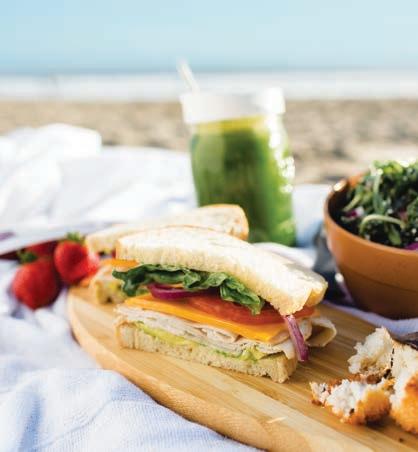
 BY LAURA SUTHERLAND PHOTOGRAPHY BY GENEVA RICO
BY LAURA SUTHERLAND PHOTOGRAPHY BY GENEVA RICO
In a garage or a backyard, five or ten gallons at a time, a brewery is born. Somebody starts experimenting with hops, malt and yeast and turns out a few gallons of beer that taste surprisingly good. They tinker some more, sampling the brew with their buddies, and compliments start to kick in.
“You should do this for real,” friends say, with both altruistic and selfish motives.
Buena Vista Brewing Company’s beginnings unfolded when tequila aficionado Phil Ornelas wanted to make his own agave spirits. He thought it would be smart to begin with beer in his learning-to-distill process, and brewed in his Hollister backyard, turning out five gallons at a time.

When Phil shared his home brew with brother Chuck, Chuck liked it so much that he wanted five gallons, too. Pretty soon Phil and Chuck designated Wednesday nights as brew nights and began to experiment more seriously.
A growing group of fans urged them to go bigger, and they searched around until they found a small industrial setup with a kombucha fermenter in Santa Cruz’s Old Sash Mill, which included just the kind of equipment they were looking for. They signed on in late 2019 with a
plan to specialize in kegs and events.
“Our first event was a taco food truck event where lots of people were expected,” says Chuck. “But COVID hit two weeks before it was scheduled and social gatherings completely stopped.
“It was clear that no one would be buying kegs for a while, and we had just signed a lease, so we had to make it work for the setting and the moment we were in.”
The brothers pivoted and bought a small canning machine, first writing the names on beer cans with Sharpie pens. But pick up a four-pack of their beer today and you’ll see color-blasted works of art that reflect their identity as Mexican Americans.
“A lot of our labels are inspired by how events are publicized in Mexico—using colorful posters on telephone poles with cool, bright, eyecatching graphics. And our beers focus on Mexican flavors,” says Chuck. “Of course, we always have a West Coast-style IPA with rotating hops, but we take our culture seriously and craft beers that highlight it.”
Take their Pelea de Gallos—it’s a French saison-style brew that uses
dried hibiscus leaves to add a slight tang and a deep ruby color to the beer, similar to the Mexican iced hibiscus drink agua de Jamaica. It’s one of Buena Vista Brewing’s most popular and refreshing beers and seems tailor made for hot summer days and nights. But like most brewers, the Ornelas brothers love to experiment, so they tried aging Pelea de Gallos in red wine barrels for a year and then bottled it, transforming it into something rich, complex and sophisticated. It’s the kind of beer you’d pull out for a special occasion. “A date night treat,” says Chuck.
Another crowd favorite, Jugo Para Adultos, has an artful mix of hops that makes it taste like oranges or mangos have been added. But if you want a brew with real mango, try Buena Vista’s Spicy Mango beer— juicy up front thanks to the addition of ripe mangos with a satisfying hit of heat on the back end. It’s double dry hopped and balanced with honey from Patti Bee Honey in Aromas to give it even more character. “We like to source locally when we can,” says Chuck.
Buena Vista creates custom beers, too. When popular downtown Santa Cruz barber shop Get Faded wanted to ensure that their clientele would really kick back and relax for a haircut or beard trim, they asked Phil and Chuck to create a special beer for that.


Get Faded owner Jose Moya notes, “We thought it would be really cool to offer a custom beer to our customers, especially since Santa Cruz is known for craft beer. We approached a few local breweries, but they were too busy. Buena Vista was new, and they were open to doing unusual small projects, so we worked together to create our hazy IPA Bien Faded.” You can sip on an ice-cold Bien Faded at the barbershop while you get your fade or taper, or buy it at the brewery or other establishments around the Monterey Bay.
Meanwhile, in mid-2020 a few dozen miles to the south at the Marina landfill, craft beer lover Jerry Garcia heard that co-worker Ulysses Fregoso was brewing really good beer in his garage just for fun, in small batches. They didn’t know each other, but when Garcia finally tasted Fregoso’s beer, he introduced himself and said, “I want to see how you do this!”
“Breaking into the commercial craft brewery industry was tough,” explains Chuck, “and we said, ‘Hey, we need to give others an opportunity, too.’
“I showed up at his house at 7:30am that Sunday and showed up every Sunday after that to brew. When Ulysses heard about Buena Vista Brewing Co. through social media, we called them up and asked to work for free in exchange for experience.”
Garcia interned for six months at Buena Vista while he and Fregoso kept up the home brewing, and eventually the owners asked if they’d like to start their own brand.



“Breaking into the commercial craft brewery industry was tough,” explains Chuck, “and we said, ‘Hey, we need to give others an opportunity, too.’ When Jerry and Ulysses approached us we were happy to help and told them we would share the space and help them get started.” Six months later in April 2021, Garcia and Fregoso brewed their first official Hillside Brewing Co. beer at the Old Sash Mill site— Midnite Peel—a crowd-pleasing black beer brewed with deeply toasted malts, orange peels and Citra hops. A few months later Fregoso’s brother Gabriel joined the team and now the three of them run the show.
Hillside’s beers showcase the owners’ identity as Mexican Americans, too. In their Hasta La Muerte—a dark stout—it’s hard to miss the south-of-the-border flavors that condition it, like the Mexican chocolate Abuelita flavor with its barely there breath of cinnamon and mazapan, a
While the breweries don’t have a tasting room, they frequently take over the taps at local restaurants.
ery can that has something personal to it. Latin Gent’z, our kolsch-style lager, is named for the car club that Ulysses used to belong to.” Its label depicts a classic car show with lowrider sedans and tricked out trucks.
Buena Vista and Hillside beers are available at the brewery—open for pickup only—but there are also plenty of shops, restaurants and pubs in Santa Cruz, Monterey and San Benito counties that carry their beers, everywhere from Las Lomas Market to Brews at the Beach at the Santa Cruz Beach Boardwalk. Keep an eye out for their tap takeovers on social media, too, at places like the Red Room in Santa Cruz, Slice Project in Watsonville, Mad Pursuit Brewing Co. in Hollister, Fourth Street Tap House in Gonzales and 101 Wine Press in Prunedale.
Both breweries have flagship beers that are constant, but “there is always R and D happening and our beers are always evolving,” says Chuck. The other constant that underscores everything they do is their respect for culture, community and paying it forward. And they make terrific beer.
Take two California trademarks—a large Mexican American population and a reputation as a craft brewing powerhouse—and it’s only a matter of time until the two converge. Lucky for us, the emerging Mexican American craft beer movement has a strong presence in the Monterey Bay area.
In addition to crafting classic IPAs and Mexico-inspired lagers, these brewers put a cultural twist on beer, adding flavors from their childhoods, like horchata, passion fruit and even nopal cactus.
Buena Vista and Hillside Breweries hold down the fort in craft beer-crazy Santa Cruz County, with brewmaster Jorge Vasquez of Watsonville’s Slough Brewing Collective adding his Latin spin to its beers.
In Monterey County, Old Town Salinas has become the epicenter of Mexican American craft brewing, with two breweries opening there so far this year.
At La Cantina Brewing Co., Horacio Davila has created a gathering place with a cool industrial vibe where he celebrates his heritage with beers like Guava Fresca and Tamarindo.
A few doors down Main Street at Brew-N-Krew Ale House, owner Marlene Garcia’s motto “Making Dope Beer Con Cultura” is seen in neon on the back wall of the glittery pub and in beers like No Es Tampico—hoppy with hints of mango, pineapple and peaches.
We’re pretty certain this trend is just the beginning. — LS


The circuitous journey that led a Dutchman to a life of contentment and a farm in Moss Landing
 BY EMILY BEGGS PHOTOGRAPHY BY DORIANA HAMMOND / WEST CLIFF CREATIVE
BY EMILY BEGGS PHOTOGRAPHY BY DORIANA HAMMOND / WEST CLIFF CREATIVE
At age 68, Windmill Farm owner Ronald Donkervoort has the same mischievous twinkle in his eye that once mirrored sunlight reflecting off the iconic greenhouses on the outskirts of The Hague. If you’ve visited him at the farmers’ markets, it’s easy to picture a teenage Donkervoort speeding away from his earliest employment in his homeland’s glassed-in growing operations, skin stained green with tomato sap, hand on the throttle of a scooter purchased with freshly earned cash.
On 10 acres in Moss Landing, Donkervoort grows albion strawberries, heirloom cabbage, coveted winter squash, plump crisp carrots, German butterball potatoes freshly dug for each market, beets, greens, spring onions, leeks, zucchini, cucumbers and cilantro, “not for the money, but because I’m totally addicted to it.”
Aside from his own passion for the pungent and nutrientrich herb, “you guys dictate what I grow,” he says, referring to the direct community feedback he receives at farmers’ markets. Donkervoort is one of the few farmers who still personally sells his produce, and he stands out not only for his wealth of organic farming knowledge, but also for the blend of cordiality, humility and playfulness he bestows upon market goers.
“It’s very rich to be in my role in the community,” he says. “I see people being born, I see people die. There’s a certain trust you get when you grow people’s food.”
Donkervoort describes himself as a “bit of a manager” in those adolescent days in the greenhouses, surrounded by tomatoes, peppers and glass walls. As an enterprising and rebellious high schooler with sights set on a life of adventure, he used his command of French to translate between his Dutch bosses and Moroccan workers while picking vegetables for pocket money. When not engaged in side hustles, music appreciation or exploration of Holland’s countryside, he occasionally made it to class, and surprised himself by managing to graduate—although skipping the ceremony.
Intolerant of the monotony and rigidity of conventional schooling, but a clever and gifted polyglot full of wonder and curiosity, Donkervoort now uses his Spanish to help workers on his own farm find housing and negotiate with landlords. “I like all that,” he explains. “It’s not just about the soil. It’s the people who work the soil. Workers have to feel good about what they’re doing.”

In total, Donkervoort speaks five languages, not counting cattle dog, or an un-
canny ability to commune with the land that yields his livelihood. He’s also a master table tennis player, having ascended his country’s highest ranks in the sport as a teenager, and a dedicated scholar of Jiddu Krishnamurti. Donkervoort is recognized as one of the few living devotees who spent considerable time in the presence of the philosopher both in the U.S. and in India. At one point, he also worked on-set for award-winning Dutch director Paul Verhoeven. These accolades are a mere drop in the berry bucket of a long life filled with the sweetness of taking the road less traveled.

Donkervoort’s values and path to becoming a farmer were shaped as much by a socialist upbringing as they were a rejection of the government office job that Dutch society expected him to take as an adult. His parents, Meintje, a school teacher, and Pier, a social worker who taught vocational skills in the prison system, modeled a life of serving their community. “It wasn’t
These accolades are a mere drop in the berry bucket of a long life filled with the sweetness of taking the road less traveled.
about money; it was about what you can do for other people,” Donkervoort recalls. Though his academic career was a sore subject for his teacher mother, he is grateful to his parents for embracing him for who he was. They had grown up in the shadows of WWII, haunted by bombings survived decades earlier. Committed pacifists, they understood why young Ronald ran away from compulsory military duty after high school, at one point tossing his machine gun into the bushes on a march. A perennial trickster, Donkervoort convinced his soldier superiors that he simply wasn’t up for the rules and rigors of basic training, repeatedly dressing himself incorrectly, getting “lost” and running away.
Looking back at past adventures from his home in the Santa Cruz Mountains—a cozy redwood cabin with hand-hewn shingle siding assembled entirely by Donkervoort himself—he recounts his early life over a tempeh sandwich and salad of Windmill Farm beets and sauerkraut, made lovingly by his partner Cate. An ornate, hand-knotted, rubycolored rug covers the floor and the walls are lined with bookshelves, altars, Southwestern prints and artifacts, and artist Cate’s rotund, whimsical ceramic figurines. Cate passes me photos of Ronald: one taken at the headwaters of the Ganges River in the 1980s and



another older, black-and-white of an Indian shrine where he sits in full lotus opposite a friend, bare chested with a long dark beard and thick mustache, hair tied up in a rope-like head cloth.
After leaving the military, panic-stricken by the thought of a life confined by the walls of an office building, Donkervoort drove taxis until he had enough money to board a cargo ship headed to South America. It was the early 1970s, and unknown to Donkervoort, the wave of military dictatorships that swept the southernmost countries of the continent was cresting. Sobered by curfews and silent city streets, yet undeterred, “I never took a bus or slept in a hotel,” he says, preferring hitchhiking, camping and homestays to tourism. At one point, he was arrested by Argentine military police who confused the wide-eyed, fair-skinned backpacker for a foreign journalist.
Eschewing comfort and consumerism in favor of freedom and serendipity, Donkervoort eventually landed in Peru where he spent three months penniless on the Amazon River. Gaunt, covered with infected insect bites and living at the mercy of locals for fish, rice and transport due to having been robbed, Donkervoort does not romanticize the serpentine passage to the Brazilian coastline, but a gleeful aura never leaves the picture he paints of his adventures. One can’t help but envision the not-yet-farmer as a spiritual mendicant, surrendering himself to the kindness of strangers for sustenance, in a manner akin to fledgling Buddhist monks.

Like many of the hippie generation, but with a singular drive to fulfill his own dreams and a tolerance for simple living, Donkervoort was transformed by later travels in India where he met lifelong teacher Krishnamurti who “put words to everything I feel.” Donkervoort was drawn to meditation as a solo camper in wilderness areas of North America and eventually made his way through Mexico. He describes pitching a tent at the now Instagram-famous ruins of Tulum with no one else in sight and planting a large garden in a highland Oaxacan indigenous community so that children wouldn’t run at the sight of a pink-cheeked, long-haired not-quite gringo. Camping and living in borrowed dwellings in areas where Spanish was seldom heard, Donkervoort observed that “the happiest people were those who lived off the land. They had time for each other, time to be with their children and grandchildren.” Their livelihoods made them self-sufficient, and they were never far from sunshine, forests and the plants they relied on for food. “One day, I will do that,” he remembers thinking to himself. “Life is so short. I have to do my own dream.”
The birth of his first child brought him from India to Santa Cruz in the early 1980s. Living in a school bus in the woods, he planned to take his family back to India, but a friend told him about a tiny piece of land for sale in Ben Lomond. The parcel happened to cost $5,000, the same sum of money the family had just received for selling the school bus. Rather
Produce at Windmill Farm in Moss Landing grows without the use of animal fertilizers.than purchasing plane tickets, Donkervoort built a tiny cabin and fashioned a water system from a spring on the steep, wooded property. He got his start growing food commercially on an organic farm in the Pogonip area of Santa Cruz, then leased land around the county before finding the acreage in Moss Landing.


On the day I visited the farm, he had just released 50,000 spiders, explaining that spider mites were one of the biggest concerns for strawberry growers, and that his pest control strategy involved “letting the animals work for you, instead of chemicals.” Standing atop the dirt clods of a freshly turned bed, clad in an ivory cowboy hat, work vest, long-sleeved plaid shirt and a sacred Hindu rudraksha seed necklace, Donkervoort professes that “whatever is good for me is also good for the soil.” He is not dogmatic about diet, but he does subscribe to a vegan way of life that revolves around eating what he grows, and no longer using animal manure composts on his crops, the farm being “an extension” of himself. Since he doesn’t know whether the animals from which he formerly sourced his compost lived good lives, free from unnecessary medications and pesticide-laden feed, he now opts for extensive cover cropping and frequent rest periods for his fields. He proudly irrigates with water from the Pajaro Valley Water Management Agency’s recycled water program, orchestrated in partnership with the City of Watsonville, to halt seawater intrusion on coastal lands. Forever treading lightly, Donkervoort remains on a mission to nourish his community and to always “try to give back to the soil, a little more than you took.”

Emily Beggs is founder and lead chef of Kin & Kitchen, which specializes in ecology-minded private chef services for clients throughout California. She has a background in the anthropology of food and nutrition, and the menus she develops meld wellnesspromoting ancestral recipes with local ingredients to create intimate and nourishing feasts.


In truth, Windmill Farm’s Albion strawberries require no additional ingredients for the perfect summer treat, but if you’d like to bake with them, this fruit-forward summer dessert evokes the nostalgia of s’mores, combining classic vanilla pastry cream, elegant Swiss meringue marshmallow crème and jammy, roast strawberries. This dessert is best approached in stages. Complete the crust, pastry cream and berries on day one, assembling the tart once all components are cool. Optimally, refrigerate the tart overnight or for a few hours, then whip up the fluffy marshmallow top, pipe it or spoon it over the tart and toast, if desired.
4 pint baskets strawberries, hulled and sliced in half lengthwise
2 tablespoons sugar
1½ tablespoon balsamic vinegar
1½ teaspoons vanilla Salt
For the crust
1¾ cups finely ground Graham cracker crumbs
2 tablespoons sugar
1 teaspoon sea salt
9 tablespoons unsalted butter, melted and browned
3 ounces dark chocolate, broken in pieces
For the pastry cream
2 cups whole milk
½ vanilla bean
¼ teaspoon salt
4 tablespoons cornstarch
½ cup plus 1 tablespoon sugar
3 large eggs
4 tablespoons unsalted butter, cut into 4 pieces
For the Swiss meringue marshmallow crème
4 large egg whites
1 cup sugar
¼ teaspoon cream of tartar
¼ teaspoon salt
1 teaspoon vanilla
To prepare the berries
Heat oven to 375° F. Hull and slice berries from 3 of the 4 baskets. Place them in a large mixing bowl and toss with vinegar, vanilla, sugar and salt. Spread marinated berries onto parchment-lined baking sheets and roast for 20 minutes or until deflated and
pooling with thickened juices. Once out of the oven, place them in a bowl and allow to cool before chilling in the refrigerator.
Hull and slice berries from the fourth basket, placing them in a small bowl when finished.
To make the crust
Heat oven to 350° F. Mix Graham cracker crumbs, sugar and salt in a medium bowl and stir until mixed. Drizzle in brown butter and mix to evenly coat crumbs. Press crumbs into the bottom and up the sides of 9½-inch fluted tart pan with a removable bottom. Then bake crust until lightly browned, about 10 minutes. After removing the crust from the oven, scatter pieces of chocolate over the bottom, then wait 30 seconds so that they begin to melt before you slide them across the crust to create an even chocolate shell. Place unroasted strawberries, cut side down, into the melted chocolate, covering as much surface area as possible. Let the crust cool, then cover with foil and place in the freezer.
To make the pastry cream
Place a fine mesh sieve over a medium-sized bowl and place near the stove. In a separate mixing bowl, whisk together the cornstarch and sugar. Once well combined, add the eggs and whisk until smooth before setting mixture aside.
Pour the milk into a heavy saucepan, then split the vanilla bean in half lengthwise and using the tip of a paring knife, scrape the vanilla seeds from the bean into the milk. Add salt to the milk and place the saucepan over mediumhigh heat, stirring occasionally to ensure that the milk solids don’t adhere to the pan.
When the milk is about to boil, slowly ladle roughly 1/3 of the hot, vanilla-scented milk into the egg, sugar and cornstarch mixture, whisking constantly. Pour the warmed egg mixture back into the hot milk and continue whisking over medium heat until the consistency of lightly whipped cream is achieved. The pastry cream must just come to a boil, then immediately be taken off the heat and poured through the sieve, to prevent overcooking.
Allow the pastry cream to cool for 3-5 minutes, then stir in the butter, taking time to whisk in each piece before adding the next. Let the cream cool so that it is warm rather than hot.
Chill the cream by covering the bowl with plastic wrap or parchment, pressing the food wrap onto the surface of the cream before placing it in the refrigerator.
Once all components are thoroughly chilled, fill the Graham cracker and chocolate shell with the pastry cream, and top with the roasted strawberries. Ideally, refrigerate the tart overnight or for a few hours, then make the marshmallow crème meringue right before serving.
To make the marshmallow crème Place a double boiler on the stove. Once the water is boiling, whisk egg whites, sugar and cream of tartar together until the sugar has dissolved completely and the mixture begins to thin. Remove from heat, add vanilla and transfer to a stand mixer. Whip on high speed until stiff glossy peaks form. If you can hold your bowl of meringue upside-down over your head without the contents plopping into your hair, you’re there.
Pipe or spoon the marshmallow crème over the tart. Use a kitchen torch or 3-5 carefully supervised minutes under the broiler to produce the campfire effect. Serves 8-10.

Join thought leaders, writers, innovators, and industry experts in Denver as we celebrate 20 years of telling the story of local food and explore the ideas, challenges and changes that will shape our food communities in the next decade and beyond.
For more information, visit edibleinstitute.com
Edible is pleased to announce Dr. Temple Grandin as our keynote speaker for this year’s Institute.
Dr. Grandin is a scientist whose ground-breaking work in animal behavior has helped shape standards of excellence for the humane treatment of animals around the world.


The amazing menagerie at Bee La Forte Farm and what it means for life on earth

Tawta was doomed. That’s how it goes with cross beak chickens.
They’re born with a condition where their top and bottom beaks don’t align, so they can’t really eat or drink, and under normal circumstances die of starvation.
Only, Tawta won the birthplace lottery, hatching in the upper reaches of Carmel Valley at a place called Bee La Forte Agroforestry Farm. That’s where a former horse ranch is being transformed into an ecological wonderland that sells eggs, alpaca-wool scarves and (eventually) a bunch more items like fruits, vegetables and select meats.
Five times a day, Tawta starts getting jumpy and her primary human, Gabriela Forte, knows to gather her “special needs house chicken” for a meal.
Often it comes with human hand-preening, because Tawta can’t do that either.
The main course starts with a special Avian Health Shake, the 35-plus ingredient list of which includes red quinoa, kelp and hemp hearts.
Gabriela mixes it with raw duck egg and powdered açai, molds that dough into a worm and pops it into Tawta’s scissored mouth.
Cross beaks never lay eggs, according to experts. But Tawta is so happy and healthy, she grunts out one beautiful pointy green-blue egg a day.
On Edible Monterey Bay’s visit, Gabriela conducted the feeding while holding Tawta on her lap. The pair sat on the couch in the country-style living room where the chicken spends most of her days and nights—wearing a custom cloth diaper— while a menagerie of animals congregates nearby.
Among them are Violetta Tequila, the fluffy 3-pound poodle, and Furbetta the calico cat.

Like all the creatures on this campus, they have unique relationships with the chickens and Gabriela.
Violetta and her mistress are so into each other, the pup drinks directly out of mama’s mug of ice water. “She thinks the water in the bowl is for peasants,” Gabriela says.
Furbetta takes her name from the Italian word for “sly” and likes to herd (and not perturb) the baby birds into their box next to the couch.
There, under a heat lamp, a range of designer fowl poke around their first days on the planet—Sebastopol geese, tiny heritage turkeys, poofy Japanese silkies and the world’s smallest chicken breed (Malaysian serama) along with the world’s rarest (ayam cemani).
The afternoon visit introduces a catalog of characters from there.
There’s the heifer Bridget Brisket, now known as Houdini for her chronic pasture escapes.

Or the gobbler Sheriff William the Conqueror, who threatens to attack newbies when they get too close to his turkey harem, but changes his crown colors—from reddish to blue—when Gabriela rubs his head.
Or Ronaldinho, the neutered alpaca, who is so hot for anything with legs Gabriela calls him “gender fluid and species fluid.”
Or the kunekune hogs Guanciale and Pancetta, who conversely refuse any romance despite Barry White soundtracks playing in the barn. “One of my team suggested Drake,” Gabriela says.
Along with an upbeat human team with its own charisma, they all contribute to the living, breathing, peeping, working landscape that is Bee La Forte.
Yet with all those characters present, none better symbolizes what the farm hopes to accomplish than Tawta.
But a mini-donkey came first.

Brazilian born chef Gabriela often speaks in 15-minute, stream of consciousness flows that are equal parts entertaining, expansive, enlightening and exhausting.
She’s also the first to call herself crazy.
When she and her husband Carlos Forte decided to replant family property near Rio de Janeiro using something called “agroforestry,” locals questioned her sanity in a less playful way.
“They said we were insane,” she recalls.
The techniques the couple applied hail from the head and heart of Swiss farmer Ernst Götsch. He moved to Brazil in 1982 to develop sustainable farming techniques known as syntropic agriculture or agroforestry.
“It’s about watching and studying how nature works…and trusting it over our own concepts,” he explains on his website. “We are part of an intelligent system, not the intelligent ones.”
Strategies include 100% diverse planting of the land, with canopyproviding cacao and other fruit trees interspersed with lower-lying vegetables, plus timber trees, flowers, grasses and grains in crop lines that might include 20 different species—as they do with early plantings at Bee La Forte—and zero pesticides or synthetic fertilizers.
In a few years Götsch transformed the poorest soils in the Bahia region into a mini-rainforest where he grows tons (and tons) of cocoa and bananas.
In Brazil, the Fortes’ lead farmer Pedro Lima was among those skeptical of such an approach. But his opinion has changed dramatically as formerly lifeless dirt now supports massive bunches of bananas
and sweet potatoes that weigh 3 pounds.
“Everyone said that nothing was going to happen in that place, because it was an abandoned land,” Lima says through a translator. “But we started little by little to plant green trees and seek experiences on how to plant and manage…the place was transformed—and I was completely transformed with what I learned about agroforestry.”
Carlos just returned from a visit to the Brazilian plot for the first time in years and the sight made him emotional.

“When you see a grown up tree where there was none, when you see fruits and vegetables all over the place, it is mind blowing,” he says.
The means to do it, meanwhile, also came from Brazil, where he worked in the family business freeze drying coffee. In the 1990s Carlos was invited to Carmel to work.
In California he developed supply chains and relationships to freeze-dry fruits and vegetables for the likes of Kellogg’s and Trader Joe’s. He eventually created Vita Forte, which today connects upwards of 80% of freeze-dried açaí to the market worldwide. Açaí, while a superfood superstar Carlos helped mainstream, represents but one of 200 different freeze-dried superfoods—a term he helped define and then globalize—in Vita Forte’s catalog.
That brings us to the donkey. As they decided to go all in on the Brazil agroforestry project, Gabriela made a request for her birthday. Carlos was thinking jewelry. She asked for a miniature donkey.
After months without any donkeys to be found in Brazil, they gave up and came up with a new plan: find some land in California where they could replicate their farming success in Brazil.
On a visit to the Carmel Valley property, the realtor gave them news he thought would dampen their enthusiasm: They’d have to inherit some animals, including a brood of chickens and…two donkeys.
“He said, ‘The house is this way, don’t you want to see it?’” Gabriela recalls. “I said, ‘All I want is to see the donkeys!’”

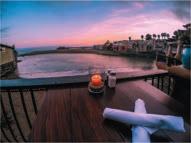
In other words, the deal was done. Today Princess and her pal Lucky have the least interesting diet of the farm, but are healthiest on hay. The chickens, ducks and turkeys who do the laying, meanwhile, fall on the other end of the menu spectrum.
They benefit from a steady supply of organic superfood processing byproduct like acerola cherry and camu camu powders, which Gabriela mixes with other superfoods and GMO- and soy-free Modesto Milling organic feed for anytime eating.
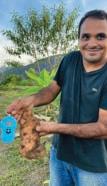
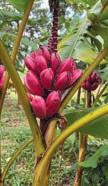

They drink coconut water (also made from freeze-dried Vita Forte product).
They do pasture pecking by day. Before bed they get a rotating dinner special that might feature still more superfoods, fresh herbs, edible flowers, wild miner’s lettuce, organic compost scraps or all of the above.
That’s what makes the eggs so desirable—and so expensive. The rare breeds they prefer also don’t come cheap. Clients like Elroy’s Fine Foods co-owner Jay Dolata are beginning to stock Bee La Forte eggs for around $20 a dozen.

“Gabby is someone who is really excited about food and where it comes from and how it’s made,” Dolata says. “She takes that all into consideration, and that’s what food is about. It’s about the impact it makes on our lives in every way.”
While the Bee La Forte Farm is now visiting restaurants and sharing its goodies with local chefs, its egg circulation has been hyperselective so far.
Le Soufflé in Carmel—which by definition is all about eggs—sources its eggs exclusively from Bee La Forte. Chef Ivan Samchenko notes he doesn’t have to age the egg whites for soufflés like he would

Gabriela is a busy bee who “can be everything and everywhere all at once,” says a long-time collaborator.

normally, that the yolks’ deep orange color leaps off the steak tartare, and that he gives all his kitchen compost to the farm to help close a loop.
“This is truly a full-cycle environment that produces the eggs—I know who’s being fed with what and where it’s coming from,” Samchenko says. “I’ve worked in a lot of restaurants. I’ve seen a lot of eggs. These are perfect.”
On the edges of Bee La Forte Farm’s expansive acreage of grassland, oak woodlands and runaway cows sits a dry river bank that Gabriela roars by in her ATV, Violetta Tequila tucked in her right arm.
She shouts over the engine, “We can bring that river back,” she says. “We can plant water.”
It seems like her boldest proclamation yet, but watch a few Götsch videos and it becomes apparent the right ecosystemic planting can create lush amounts of moisture, boost soils and ease heat quotients.

At the Brazilian farm, manager Lima marvels at how 104-degree days just four years ago now are in-the-80s afternoons because of the forest they’ve sown.
The drought that dried the river contributed to the 2020 Cachagua Fire that burned to the doorstep of Bee La Forte Farm, and January 2022’s out-of-season Colorado Fire in Big Sur.
Carlos was there for the latter as a Mid Coast Fire Brigade volunteer. Gabriela joined the effort by cooking and delivering hot meals to the volunteers much as she did for weeks straight during the Soberanes Fire in 2016.
Carlos remembers 30-foot-high flames in Palo Colorado. Mid Coast Chief Cheryl Goetz puts them closer to 100 feet.
In their volunteer efforts the Fortes are active in confronting a scary outcome of climate change.
In their work on the farm, they aim to treat the sickness, not the symptoms—and want to build out a farm school program to help others functionally repopulate ecosystems. The former executive director of MEarth environmental education program, Ben Eichorn, was recently signed on to bring it all to fruition.
“If we can’t do it in a way that other people can see that it works and that they can do it, we’re not doing what we want to do,” says Gabriela.
She acknowledges it can be easy to feel hopeless when massive monoculture farms use pesticides and subsidies to extract maximum yield with minimal consideration about species interplay and soil quality.
“The planet is being destroyed and that’s heavy to deal with,” she says. “It doesn’t mean we’re going to accept it. We can be smarter.”
That’s why Tawta is the best mascot for Bee La Forte.

Like us, she could’ve been doomed, but the Fortes weren’t feeling that. Now, with the right love, nutrients and species around her, Tawta is thriving.
With every egg-laying miracle, you can almost hear her clucking, “Not today, doomsday.”
Mark C. Anderson is a roving writer, explorer and photographer based in Monterey County. Follow and/or reach him on Twitter and Instagram @MontereyMCA.








When bees and butterflies buzz by the Homeless Garden Project in Santa Cruz, it must look like a heavenly snack bar and sanctuary, all in one.
Farm manager Ella Fleming knows that HGP’s organic operation depends on pollinating insects to ensure decent crop yields so that it can keep its farmstand well stocked. The farm grows more than 50 varieties of flowers—which are sold as cut flowers at the stand—and also lure precious pollinators. Native flowers and shrubs, butterfly bush, marigolds, dahlias, lavender, snapdragons and Shasta daisies provide food and shelter for both native insects and European honeybees on the property.
But most importantly, Fleming says, “As an organic farm, we never spray any chemicals that may interfere with pollinators’ health or life cycle.”
Pollinator-friendly gardening is now a trend in sustainable circles, creating an environment that encourages bees, butterflies and other insects to come in, get some nectar and stay a while. It’s not just a fad, but a movement with serious intent: to provide safe space for these beneficial insects, many of which have been impacted by habitat destruction and pesticide use.
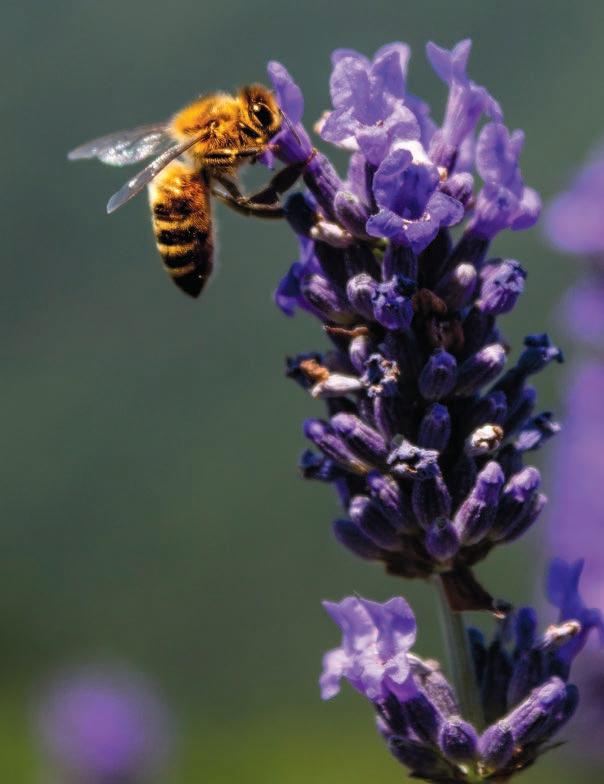

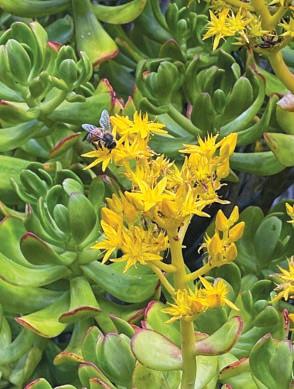
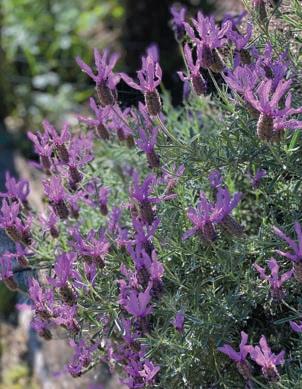
Home gardeners, urban garden keepers and organic farmers can help rescue pollinators—simply by providing a little oasis for them that includes nectar plants, hiding places, shelter and a shallow water source.
Dr. Stacy Philpott of the UC Santa Cruz Center for Agroecology has made urban gardens her focus in an ongoing research project. Philpott, who spoke about her work in conjunction with a pollinator exhibit at the Santa Cruz Museum of Natural History, says she has been intrigued by urban gardens since the late 1990s.
Since 2013, she has headed a team that gathers data from 25 gardens, including HGP, Aptos Community Garden and Santa Clara University. Philpott’s findings bolster the idea that gardens can be important places of refuge for pollinators, and that pollinators contribute to the biodiversity of gardens.
When we think of bees, it’s usually the European honeybee that comes to mind. But there are hundreds of native bees in California, which come in all different shapes, sizes and hues. Some come in brilliant colors; others are shiny black, and many are fuzzy or hairy, like bumblebees. It’s those hairs that help them pass pollen from flower to flower.
And that spreading of pollen is all important. Pollination is key to most plants’ ability to form seed-bearing fruits—so if we don’t have pollinators, say goodbye to squash, peppers, tomatoes, avocados, plums, pistachios, melons and a whole lot of other good things to eat. Plenty of other pollinators are out there as well, including beetles, flies and hummingbirds.
“About 35% of our food crops rely on insect pollination, and all sorts of native plants cannot survive without insect pollinators,” says Philpott. “So it is essential for our well-being and for the well-being of all of the earth’s biodiversity to do our best to understand and conserve pollinators.
Gardens are one place where humans and pollinators can both thrive, even in sprawling cities.”
Philpott has a special interest in native bees, and confesses that she has a special affection for the ultra-green sweat bee, Agapostemon texanus.
“This is my favorite because it is so unique with both the metallic green head and thorax, and more ‘bee-like’ yellow and black striped abdomen,” she says. Another unusual one she’s glimpsed locally is the leafcutter bee: “I have literally seen bees flying around carrying little leaf fragments, which is the only way I’d be able to identify it in the field!”
Bees aren’t the only pollinators that can benefit from sustainable, organic gardening. Butterflies will also benefit from the same simple steps.
Madeline Kangas, a Central Coast monarch butterfly conservation planner with the Xerces Society for Invertebrate Conservation, works with farmers to create habitat for the migratory butterflies on working lands. “My focus is mainly on the planting and management of monarch breeding habitat as well as other pollinators, but the neat thing about that is much of what we’re doing for the monarch is beneficial for a whole host of invertebrates,” she says.

If we don’t have pollinators, say goodbye to squash, peppers, tomatoes, avocados, plums, pistachios, melons and a whole lot of other good things to eat.
Her first tip is to plant pollinator-friendly flowers to provide pollen and nectar. “For monarchs, it’s also important to include native milkweeds because the caterpillars will only feed on this plant,” although she recommends these be planted at least 5 miles from the coast, so they don’t disrupt monarchs’ natural behavior.
Kangas also suggests providing nest sites for pollinators—many native bees live in patches of bare ground or in dead pithy stems. Gardeners should be sure to keep some patches of ground bare, with no weed cloth or mulch, to accommodate ground-nesting bees.
Gardeners can also aid pollinators by providing a year-round smorgasbord of blooming plants. It’s particularly important to include plants that bloom during late fall, winter and early spring, when not much else is in flower.
Cara Meyers, the owner of DIG Gardens in Santa Cruz and Aptos, recommends succulents as an ideal pollinator plant—many, such as the jade plant, bloom prolifically in the winter and early spring. “People might not think of them (as a pollinator plant), but they’re always great to include in the garden,” she says. She also recommends a combination of annuals, like sunflowers and calendula, in addition to perennials such as yarrows, salvias and echinacea. Ceanothus and manzanita, early-blooming California natives, are also a good bet.
Gardeners can also help spread the word about what it takes to help pollinators, and work to support urban gardens. Volunteers at public parks in Seaside, for instance, are creating and maintaining pollinator-friendly habitat. Over the past few years, “it’s grown in reach,” says Laura Murphy, a member of the city’s Environmental Committee, with “a very consistent group” of 20 volunteers who work each Saturday, rotating among different parks to water, weed and plant natives. This commitment has earned Seaside the designation of Bee City USA, an initiative of the Xerces Society.
• UC Berkeley Urban Bee Lab (nature. berkeley.edu/urbanbeegardens) includes a catalog of bee-attracting plants, tips on providing habitat and lots of clear, easyto-understand information on why bees are important in the scheme of nature.
• Xerces Society has a list of pollinator plants (xerces.org/monarchs/monarchnectar-plant-guides).

• Honey Bee Suite provides information and great photos of native and non-native bees (honeybeesuite.com/whos-thatpollinating-my-garden).
• Sustainable Seaside works to maintain pollinator gardens (sustainablemontereycounty.org/seasidehome).
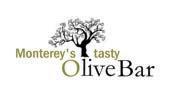

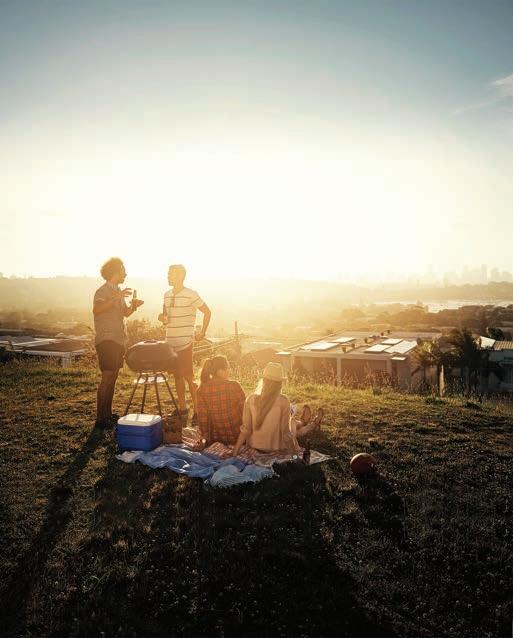


Wash
Makes: 4-6 servings Time: 10 minutes 1. Place the chickpeas, tahini, olive oil, garlic clove and lemon juice into a blender or food processor. Mix for about 30 seconds or until you have a thick paste. 2. Add in the salt. Continue to mix, slowly adding spoonfuls of water until you have a smooth and creamy paste.
LET’S GATHER:
• 1 large carrot
• Hummus
• 8 slices whole grain bread (small loaf)
• 8 half-inch slices of cucumber, cut in half
• 4 cherry tomatoes
• Vegetable peeler

• Table knife
• Cutting board
• 4 small wooden skewers


Makes: 4 Time: 10 minutes
1. Peel the outer skin from the carrot and cut off the base. 2. Continue to peel and make long carrot curls. 3. Spread the hummus onto a piece of whole grain bread. Cover with another piece of bread to make a sandwich. Repeat with the remaining hummus and bread. (Use our recipe on the left, or store-bought hummus works too!) 4. Use the table knife to remove the crusts and cut the sandwiches into quarters. 5. Place one sandwich piece onto the cutting board and push a skewer through the middle.
6. Repeat this using a piece of cucumber, a few carrot curls, a sandwich, a cherry tomato, a sandwich, carrot curls, cucumber and another sandwich. Make sure you always push the skewer through a chunk of food and onto the board.
Summer is the time to start thinking about foods we will need to harvest in the fall. Let’s plan our own “three sisters” garden!
Plants, like people, often help one another out. Sometimes known as the “three sisters,” Indigenous peoples in North America discovered that sweet corn, beans and squash work well when planted together.
producing their fruits and seeds, make a soup or stew and enjoy the harvest!
Clear a circular space about 6 ft (1.8 m) in diameter in a part of your garden that gets plenty of direct sunlight.
Prepare the soil in this area by watering, digging and adding finished, finely sifted compost until the soil is loose and crumbly.
Create a mound of soil about 12 in (30 cm) high and about 5 ft (1.5 m) across.

Plant 6 sweet corn seeds in the middle of the mound, about 12 in (30 cm) apart.
5. Water your sweet corn regularly and watch it grow.

6. Approximately 4 – 8 weeks later when the sweet corn is about 8 in (20 cm) tall, plant the bean seeds in a circle around it about 4 in (10 cm) away from the sweet corn.

7. At the same time, plant 4 squash seeds spaced evenly around the outer edges of the mound.


8. Watch your Three Sisters work together to grow tall and strong.

A rooftop garden is what we need — Friends and family all agree.
A garden starts with hardy seeds. A rooftop garden is what we need.
Dig a hole and in they go.
Sow the seeds with a shovel and hoe. Plant them, pat them, row by row. Dig a hole and in they go.
Grow, garden! Grow, garden! Grow, garden! Grow, grow, grow!
Lots of sun and a little shade
Bring lettuce, carrots, mint and sage. Mark them with the signs we made. Lots of sun and a little bit of shade.
Water the soil when it gets dry.
Time to wait till – me-oh-my!
Tiny shoots reach for the sky. Water the soil when it gets dry.
Grow, garden! Grow, garden! Grow, garden! Grow, grow, grow!
Pull the weeds and make a stack. Pesky weeds! We fill a sack. Pick them, pull them, they grow back! Pull the weeds and let’s make a stack.
Garden friends fly to and fro, Spreading pollen as they go — Dust that helps the veggies grow. Garden friends, they fly to and fro.
Watch the animated video & listen to the song at www.barefootbooks.com/rooftopgarden
Grow, garden! Grow, garden!
Grow, garden! Grow, grow, grow!
Grab your gloves and fill a jug. Gather slimy snails and slugs. Say goodbye to hungry bugs! Grab your gloves and fill a bug jug.
Time to harvest our rooftop crop. Pick and pull and twist — don’t stop! Fill the baskets to the top.
Time to harvest our own rooftop crop.
A garden feast! Oh, what a treat. Prepare the food and take a seat. Pass a plate and let’s all eat. A garden feast! Oh, what a treat.
Yum, garden! Yum, garden! Yum, garden! Yum, yum, yum!
Thousands of kinds of plants exist in the world. And while they are all very different, most of them follow the same stages of growth.
Stage 2:
During seed growth, nutrients (materials needed to grow) inside the seed help it sprout. This is called germination.
As a seedling, the roots grow down into the soil as green leaves grow above the ground.
Stage 3: Vegetative Once enough leaves have formed, the stem gets taller and the leaves larger as the growth of flower buds begins.
While the plant continues to get bigger, the flower buds are getting ready to bloom.
Stage
When the flowers bloom, pollinators like birds, bees and butterflies visit them to drink nectar (sweet juice) and pick up pollen. Then the flowers fall off and the plant grows fruits or vegetables.
Stage
At the final stage, the fruit is fully grown, ready to harvest and enjoy!
is created in partnership with indie, award-winning, Concord, Massachusetts-based children’s publisher, Barefoot Books. Learn more about Barefoot Books by visiting www.barefootbooks.com.



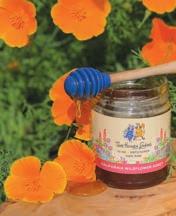





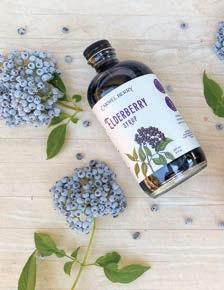
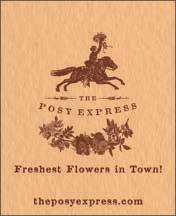


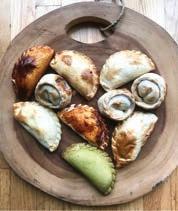
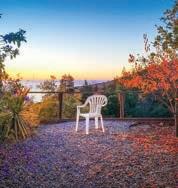



























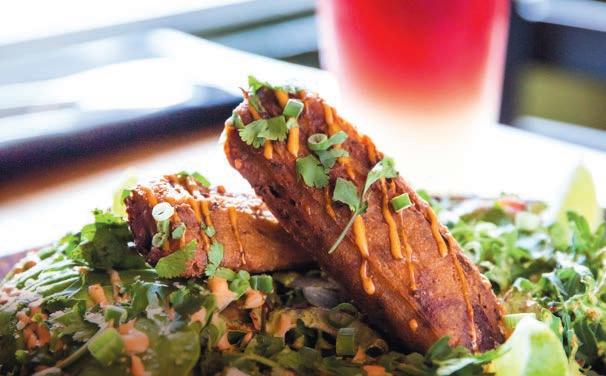
Persephone 7945 Soquel Drive 831.612.6511 • persephonerestaurant.com
With a namesake like the mythic Persephone, this restaurant in Aptos proclaims its deep reverence for seasonal cooking. Themes central to harvest, winter and spring are core to Persephone’s story, and are reflected in the changing menu at this fine dining destination, where chef Cori Goudge-Ayer presents inventive, ingredientdriven creations. The restaurant is a family-run passion project, bringing together parents, siblings and a long history of culinary arts in a beautifully redesigned space overlooking Aptos Creek. Open Th–Su noon–3pm, 5–close, Th–Sa. Second Sundays, themed wine tastings with small bites. Fourth Sundays, Winemakers Dinner with five-course pairing.
New Leaf Community Markets 161 Aptos Village Way 831.685.8500 • newleaf.com
This latest branch of the beloved local market group occupies the remodeled Hihn Apple Barn, built in 1891. In addition to local groceries and organic produce, New Leaf Aptos has made-to-order sandwiches, pizza, freshly rolled sushi, soup and hand-prepped salads, as well as a coffee bar, juice and smoothie bar and organic Straus soft serve ice cream. Open daily 8am–9pm.
The Penny Ice Creamery
141 Aptos Village Way, Suite 2 831.204.2523 • thepennyicecreamery.com
Open Su–Th noon–9pm, F–Sa noon–10pm. See The Penny description under Santa Cruz for more.
East End Gastropub 1501 41st Avenue 831.475.8010 • eastendpub.com
East End Gastropub is a sister eatery to the popular West End Tap & Kitchen, but aside from sharing owners and chefs, East End’s beautiful, modern interior is entirely different and offers its own robust, sophisticated, beerfriendly menu. Chef Geoffrey Hargrave has created dishes that are familiar yet innovative, such as crispy Brussels sprouts with maple miso glaze and fresh fish en papillote. Shared plates, pizzas and salads come in generous portions for a family-style meal. The restaurant also offers a rotating selection of local beer and a strong wine list. Open M–Th 4–9pm, F noon–9pm, Sa-Su 11am–3pm for brunch, and 4–9pm.
Margaritaville Capitola 231 Esplanade 831.476.2263 • margaritavillecapitola.com
For more than 30 years, Margaritaville has been welcoming guests to Capitola Village. An ownership change and complete remodel in 2015 made the restaurant better than ever, dedicated to serving Mexican cuisine made from scratch with an emphasis on fresh seafood. The dog-friendly patio overlooking Capitola beach is a great place to enjoy a margarita and a Baja fish taco, or raw oysters on the half shell. Other menu favorites are chile verde and chicken mole enchiladas. Online ordering is now available. Happy hour M–F 3–5pm. Open M–F 11:30am–9pm, Sa–Su 11am–9pm.
New Leaf Community Markets
1210 41st Avenue
831.479.7987 • newleaf.com


The café at the entrance offers great alternatives to fast food, serving economical daily specials, wraps, pizza and homemade soup and espresso drinks—with free wi-fi in the outdoor dining area. Inside the market, a full deli has made-to-order sandwiches, healthy takeout salads and entrée items. Open daily 8am–9pm.
The Penny Ice Creamery
820 41st Avenue 831.204.2523 • thepennyicecreamery.com
Open Su–Th noon–10pm, F–Sa noon–11pm. See The Penny description under Santa Cruz for more.

Shadowbrook
1750 Wharf Road 831.475.1511 • shadowbrook-capitola.com

A Santa Cruz County landmark since 1947, the worldfamous Shadowbrook continues to be an overwhelming favorite with locals and visitors alike. Its fine food, extensive wine list and unparalleled setting and ambiance have earned it numerous awards, including Northern California’s “Most Romantic Restaurant” and “Best Date Night Restaurant.” Rock Room Lounge and Patio open daily noon–10pm, dining rooms open M–F 4–8:30pm, Sa 2–9:30pm, Su 2–8:30pm.
Alvarado Street Brewery & Bistro

Carmel Plaza, Suite 112 831.293.8621 • asb.beer
From the team behind award-winning Alvarado Street Brewery, the Carmel bistro offers a full menu of ASB brews, along with hard cider, local wines and inventive craft cocktails. The menu goes beyond pub food to include oysters with mignonette or chili oil, Moroccan spiced fried chicken, crispy tempura-battered cauliflower and its popular burgers with truffle or garlic fries. Open Su–Th 11:30am–9pm, F–Sa 11:30am–10pm.
Covey Grill

8205 Valley Greens Drive 831.620.8860 • quaillodge.com/dining/coveygrill Covey Grill features USDA steaks and sustainably sourced seafood flavor enhanced by house-made spice rubs and sauces, in addition to seasonal American cuisine. Located inside the Quail Lodge lobby, Covey Grill offers casually elegant indoor and outdoor dining options against the stunning backdrop of Quail’s sparkling Mallard Pond and lush garden landscapes. Open for full dinner service Th–Su 5–9pm, with bar opening at 4pm, and M–W 4–8pm with weekday menu.
Earthbound Farm’s Farm Stand 7250 Carmel Valley Road 831.625.6219 • earthboundfarm.com
At its newly renovated Carmel Valley Farm Stand, Earthbound Farm’s 100% certified organic kitchen delights with housemade soups, sandwiches, salads, baked goods and fresh juices and smoothies. Food is available to be enjoyed on our beautiful grounds or for takeaway. Stroll through the gardens and learn about Earthbound’s commitment to organic integrity. Open daily 8am–6pm.
Grasing’s
6th Avenue and Mission 831.624.6562 • grasings.com
Chef-proprietor Kurt Grasing’s namesake restaurant has
expanded since opening in 1998 to include two large dining rooms, multiple outdoor dining areas and the everpopular bar/lounge. A Carmel classic located in the heart of the village, Grasing’s serves California cuisine, with an award-winning wine list and twists on traditional cocktails. Open daily M–F noon–3pm and 5–9pm, Sa–Su 10:30am–3pm and 5–9pm.
Rio Grill

101 Crossroads Boulevard 831.625.5436 • riogrill.com
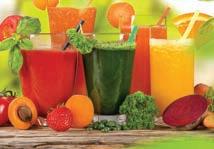


Deeply flavorful Southwestern cuisine is the specialty that executive chef Luis Osorio brings to the table for lunch and dinner. Go exotic with a corn truffle and wild mushroom tamale, go local with the fire-roasted Castroville artichoke or go wild west with an order of almond wood smoked BBQ pork back ribs. Open Su–Th 11:30am–8pm, F–Sa 11:30am–9pm.
Sea Harvest Fish Market & Restaurant 100 Crossroads Boulevard, Suite A 831.626.3626 • seaharvestfishmarketandrestaurant.com
The Deyerle family that owns this local gem has its own fishing boats for the freshest catch on the Monterey Peninsula. Sea Harvest doubles as a fish market and casual restaurant with indoor and outdoor seating. The oysters and clam chowder are customer favorites, but don’t miss the fried combo platter, grilled fillets and fish tacos. Open daily 8am–8pm.
San Carlos Square, Between 5th and 6th avenues 831.250.7183 • thestationaery.com
A neighborhood restaurant offering daily brunch and lunch, Stationaery is owned by your hospitable hosts Anthony and Alissa Carnazzo. The kitchen team, led by chef Amalia Scatena, specializes in comforting flavors and local ingredients, with elegant presentations. A new bottle shop next door offers a good selection of European and California wines to enjoy with your meal or take home. Open W–M 8am–4pm. Closed Tu.
Jerome’s Carmel Valley Market
2 Chambers Lane 831.659.2472 • jeromescarmelvalleymarket.com
A chef-owned, friendly neighborhood market, Jerome’s offers local and organic produce, natural meats and seafood, and a great selection of domestic and imported wine, beer and microbrews. French-trained chef and owner Jerome Viel prepares delicious hot foods, sandwiches and salads for eating at outdoor seating or take-away. The offerings start with breakfast burritos, croissants and other French pastries in the morning, followed by favorites such as coq au vin, spaghetti carbonara and chicken enchiladas for lunch and dinner. Open M–Sa 7am–7pm, Su 7am–6pm.
Lucia Restaurant & Bar
Bernardus Lodge & Spa • 415 W. Carmel Valley Road 831.658.3400 • bernarduslodge.com
Indulge in artisanal California country cuisine, awardwinning wines and an expansive heated outdoor terrace with the finest restaurant view in Carmel Valley. At this Forbes 4-Star charmer, named for the Santa Lucia mountain range and wine appellation that beckons to the south, executive chef Christian Ojeda offers both a signature tasting menu and dishes à la carte. Wine list is equally notable. A chef’s table and wine cellar are also available for private dining and special occasions. Open daily 7am–9pm.
Wild Roots Market
6240 Highway 9 • 831.335.7322 (Felton)
13159 Highway 9 • 831.338.7211 (Boulder Creek) wildrootsmarket.com
Wild Roots’ 100% organic produce, natural groceries, organic meats and FishWise-certified seafood all go into the prepared foods offered by the store’s full-service deli, salad and soup bar and juice bar. Enjoy on the patio out in front or take home. Open daily 9am–9pm.
Elroy’s Fine Foods

15 Soledad Drive 831.373.3737 • elroysfinefoods.com
The dream market of owners Jay and Chloe Dolata, Elroy’s has an extensive range of gourmet groceries, local seafood, natural meats and fresh organic produce. It also boasts a kitchen with a wood-fired grill and prepared foods to go or to eat in. The Bar @ Elroy’s serves coffee, smoothies and a savvy selection of natural wines. Open M–Sa 8am–8pm, Su 9am–7pm.
Estéban Restaurant


700 Munras Avenue 831.375.0176 • estebanrestaurant.com
At the heart of the downtown Monterey dining scene, Estéban Restaurant serves Spanish influenced cuisine made from fresh, local, and seasonal ingredients. The menu features a selection of long-time Estéban favorites, as well as fresh, new dishes created by executive chef Mario Garcia, who spins out wonderful dishes like Crispy Pulpo, served with remoulade, Yukon potato, chorizo, rosemary chili oil and grilled radicchio. Open for dinner nightly 4–8pm. Tapas hour from 4–6pm nightly.
Jacks Monterey
2 Portola Plaza 831.649.7830 • jacksatportola.com
Jacks Monterey provides a refreshing culinary experience in downtown Monterey, inside the Portola Hotel & Spa. Emphasizing local ingredients, high-quality seafood, and an award-winning wine and cocktail program, Jacks philosophy derives from globally-inspired traditions of California Cultural Cuisine. The atmosphere at Jacks is sophisticated—never pretentious. Open for breakfast W-Su 6:30–10:30am, dinner W-Su 4–10pm, and bar only F-Sa 10–11pm.
Montrio
414 Calle Principal 831.648.8880 • montrio.com
Executive chef Sascha Lyon brings a lifetime of experience in some of the country’s top fine dining restaurants to the reimagined Montrio—located in a 100-year-old former firehouse. The extensive “cutting edge Californian” menu includes oysters, wood-fired Spanish octopus and onion soup gratinée, along with in sustainable seafood dishes, local organic produce, prime meats and housemade desserts. Open W–Th 5–9pm, F–Sa 5–10pm, Su 5–9pm.
Peter B’s Brewpub
2 Portola Plaza 831.649.2699 • peterbsbrewpub.com
Peter B’s Brewpub combines award-winning craft beer and sports on 18 high-definition televisions in a relaxed brewpub environment. Monterey’s original craft brewery is distinguished for its variety of beer on tap, innovative
pub menu, happy hour, sports bar atmosphere, and outdoor dining on the pet-friendly heated patio with fire pits. Peter B’s is open Wednesday-Sunday with nightly happy hour from 4–6pm, as well as late night happy hour 9–10pm. Open W-Su 4–10pm. Sunday breakfast and football 9:30–11am from September to January.



Revival Ice Cream 463 Alvarado Street 831.747.2113 • revivalicecream.com

Revival serves up lovingly handcrafted, small batch organic ice cream, made using the freshest, in season, locally sourced ingredients. Favorite flavors include Bees Knees, Eucalyptus Mint Chip, Dark Chocolate and Cold Brew Coffee. Plenty of vegan and dairy-free ice creams are available, as well as vegan, gluten-free waffle cones baked in house and ice cream sandwiches. Open Su–Th noon–9pm. F–Sa noon–10pm.
Sea Harvest Restaurant & Fish Market 598 Foam Street 831.626.0547 • seaharvestmonterey.com
This fresh and casual seafood spot near Cannery Row is perfect after a day exploring the Monterey Bay Aquarium. There are grilled entrées and lots of fried options with chips, including calamari, clams, prawns, scallops and oysters. Try Sea Harvest’s popular clam chowder or a basket of crispy artichoke hearts. Open daily 9am–7pm.
Stokes Adobe 500 Hartnell Street 831.264.8775 • stokesadobe.com
Located in one of Old Monterey’s historic adobe homes, now beautifully restored, Stokes Adobe offers fresh pastas made in house, truffle chicken and shareable appetizer plates. The bar and cozy outdoor fire pits feature seasonally inspired classic cocktails, and a selection of quality wines by the glass and local beer. Friendly, welcoming staff make sure your visit feels like coming home. Open Th–Sa 5–9pm. Check online for expanded days, hours, lunch and brunch service.
Tarpy’s Roadhouse 2999 Monterey-Salinas Highway 831.647.1444 • tarpys.com
An award-winning steakhouse serving generous portions of California comfort food, Tarpy’s Roadhouse occupies a sprawling 3½-acre property and stone building that used to be part of the Ryan Ranch homestead. In addition to expertly prepared steak, enjoy wood-fired salmon, chilecrusted chicken, braised lamb shank, classic meatloaf and smoked baby back ribs. Open Su–Th 11:30am–8pm, F–Sa 11:30am–9pm.
Wild Plum Café & Bakery

731 Munras Avenue 831.646.3109 • thewildplumcafe.com
Located in Old Monterey in a vibrant and diverse neighborhood, Wild Plum draws people from all walks of life with sustainable bistro fare that uses organic, locally sourced produce, hormone-free Diestel turkeys roasted on site, grass-fed beef and house-baked bread and pastries. Breakfasts include scrambles, omelets, and breakfast tacos and burritos, and for lunch, choose among soups, salads, sandwiches and paninis, burgers and house specialties. Food to go and catering available. Open W–M 7:30am–3:30pm, Tu closed.
Sea Harvest 2420 Highway 1 831.728.7081 • @seaharvestmosslanding
Outdoor tables on a wooden deck overlooking Elkhorn Slough are the perfect place to enjoy fresh seafood hauled in by a fisherman who is part of the Deyerle family that runs the restaurant. Choose from grilled catch of the day, shrimp Louie, fish and chips or some of the best Baja-style battered fish tacos around. Open daily 11am–7pm.

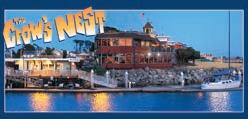
Julia’s Vegetarian 1180 Forest Avenue, Suite F 831.656.9533 • juliasveg.com
Voted the best vegetarian restaurant on the Monterey Peninsula for more that 10 years running. Julia’s is known for its wild and exotic mushrooms and house-brewed kombuchas on tap. The menu features a creative twist on vegan, vegetarian and gluten-free food. Try some of the most popular dishes like the fried “egg & bacon” sandwich, exotic mushroom sampler and buffalo cauliflower wings. Open Su–Th 8:30am–9:30pm, F–Sa 8:30am–10:30pm.
Mezzaluna 1188 Forest Avenue 831.372.5325 • mezzalunapasteria.com
Owners Chef Soerke Peters and Amy Stouffer keep their restaurant simple and amazing—and chef Peters is a leader in sustainability on the Monterey Peninsula. Pasta, mozzarella and gelato are made fresh daily. Starters include clam chowder with torched bone marrow, duck liver pâté and grilled octopus, and there are five dishes starring locally crafted mozzarella. Pasta choices are imaginative and include options such as pappardelle with wine braised rabbit, Dungeness crab ravioli and potato gnocchi with gorgonzola and black truffle oil. Open W–Su 5–9pm. Closed M–Tu.
Wild Fish 545 Lighthouse Avenue 831.373.8523 • wild-fish.com
Owners Liz and Kelvin Jacobs welcome you to feast on the bounty of nearby waters and farms at their 100% local and organic seafood house, enjoying exquisite dishes like crispy sablefish, halibut and petrale sole, accompanied by local vegetables. Chef Elsah Payne also prepares fresh oysters, innovative salads, house-baked bread and sides like fingerling potatoes with poppyseed crème fraîche or baby carrots with wild nettle pesto, make this a dining destination. Did we mention English sticky toffee pudding for dessert? Open Su–Th 11:30am–3pm and 5–8:30pm, F–Sa 11:30am–3pm and 5–9:15pm.
Vertigo Coffee Roasters

81 Fourth Street
831.623.9533 • vertigocoffee.com
Artisanal coffee roasted on site as well as fresh pastries baked in-house, brunch items, local craft beers and wines, plus wood-fired pizzas with naturally leavened, twice fermented sourdough crust have made Vertigo a locals’ favorite as well as a great find for visitors en route to the San Juan Mission, Pinnacles or other area attractions. Open T–Su 8am–6pm.
Barceloneta
1541 Pacific Avenue, Suite B 831.900.5222 • eatbarceloneta.com

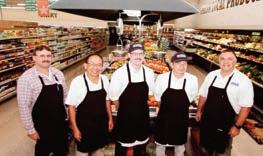

With its cheerful beach stripes, wicker light fixtures and whimsical details, dinner at Barceloneta can feel like a holiday. Owned by chef Brett Emerson and his wife Elan, who ensures service is superb, Barceloneta offers Spanish tapas made with seasonal, farmers’ market produce and several types of authentic paella, along with Spanish wines, beers and cocktails. Open Tu–Sa 5–8:30pm. Closed Su–M.
Bookie’s Pizza
1315 Water Street bookiespizza.com
Located inside the Santa Cruz outpost of Sante Adairius Rustic Ales, Bookie’s Pizza is owned by fine dining veteran chef Todd Parker and offers “inauthentic” Detroit-style square pies. Each pizza is made using the best seasonal ingredients from local farms, fishermen and foragers. Dough is made with organic flour, naturally leavened for 48 hours, and each pizza comes with its own unique sauce. Open Su–Th noon–9pm. F–Sa noon–10pm.
Chocolate 1522 Pacific Avenue 831.427.9900 • chocolatesantacruz.com

As its name suggests, there are all kinds of decadent chocolate desserts at Chocolate the restaurant, but this farmto-fork local favorite is much more than a dessert spot. Everything is prepared simply and with local and organic ingredients whenever possible. Open Tuesday through Sunday for dinner, options include three kinds of chicken mole, roast pork with chocolate barbecue sauce, and their signature Pasta Rosettes! Cocktails feature Santa Cruzbased distilleries, including Venus Spirits. Check out their extensive hot chocolate menu. A party room for your special celebration is available, with seating and menu options to suit the occasion. Open Tu–Th and Su 4–8pm, F–Sa 4–9pm. Closed M.
Crow’s Nest 2218 E. Cliff Drive 831.476.4560 • crowsnest-santacruz.com
A perfect spot to enjoy breakfast and lunch or catch a dinnertime sunset over the harbor, the nautical-themed Crow’s Nest is a Santa Cruz institution that never goes out of style. There’s always something happening, from live music to comedy nights and happy hours. Famous for its salads, house-smoked salmon and seafood entrées, the Crow’s Nest is a member of Seafood Watch and is a certified green business. Open M–F 9am–8:30pm, Sa–Su 8am–8:30pm.
Laílí 101B Cooper Street 831.423.4545 • lailirestaurant.com
Exotic flavors of The Silk Road are served in a stylish dining room decorated in eggplant and pistachio colors and on a hidden candlelit patio. Locals rave about Laílí’s homemade naan served warm from the oven with a selection of Mediterranean dips. There is a wide variety of deliciously spiced vegetable dishes, and all meats are hormone free and free range. Check website for opening information.
La Posta 538 Seabright Avenue 831.457.2782 • lapostarestaurant.com
A cozy neighborhood bistro not far from the Santa Cruz yacht harbor, La Posta chef Rodrigo Serna prepares traditional rustic Italian cuisine using local ingredients. The emphasis is on simple, seasonal selections, with the bal-


CARMEL-BY-THE-SEA
San Carlos & 7th 831.626.WINE (9463)
1972 Hobson Ave., Greenfield 831.386.0316
scheidvineyards.com



ance of the menu reflecting whatever produce is freshest right now. A sister restaurant of Soif Restaurant and Wine Bar, La Posta also offers a great selection of wines. Open W–Su 5–8pm, closed M–Tu.
New Leaf Community Markets
1134 Pacific Avenue 831.425.1793 • newleaf.com
New Leaf’s headquarters in a former bank building on Pacific Avenue is a worthwhile stop for all foodies. Crowded with gourmet natural foods, it also has a deli with sandwiches, salads and hot entrées. A dining area out front is great for people watching and listening to street musicians. Open daily 8am–9pm.
New Leaf Community Markets
1101 Fair Avenue 831.426.1306 • newleaf.com
The Westside New Leaf has a large deli counter and coffee bar, with a big selection of sandwiches, salads, bakery items, soups and other hot foods. You can eat at an instore counter or at tables outside. Open daily 7am–9pm.
The Penny Ice Creamery
913 Cedar Street 831.204.2523 • thepennyicecreamery.com
Lines out the front door of its converted Spanish bungalow are evidence of Penny’s popularity. All ice cream, including bases, is made from scratch on the premises using local organic ingredients when possible. Dozens of exotic flavors rotate seasonally, but two favorites are chocolate caramel sea salt and strawberry pink peppercorn. Open daily noon–11pm.
The Picnic Basket
125 Beach Street 831.427.9946 • thepicnicbasketsc.com
Across the street from the main beach, owners of The Penny Ice Creamery have opened an alternative to boardwalk fast food. Sandwiches, organic salads, coffee and beer, all from local food artisans, and of course Penny’s popular ice cream, are all on offer to eat in or outside with your feet in the sand. Open daily 7am–4pm.
Snap Taco 1108 Pacific Avenue 831.824.6100 • eatsnaptaco.com
This festive taco spot draws its inspiration from food traditions around the world, with imaginative tacos created using the best fresh, local and sustainable ingredients. Great for a quick bite or gathering with friends and family. Choose from snacks, tacos, bowls and sandwiches on the menu, as well as draft beers, the Snap Rita and specialty cocktails. Open Su–Tu and Th 11:30am–9pm, F–Sa 11:30am–10pm, closed W.
Soif Restaurant and Wine Bar 105 Walnut Avenue 831.423.2020 • soifwine.com
Soif lives on as a bottle shop offering more than 400 hardto-find European and local wines, along with a wine bar serving wines by the glass. Pull up a barstool and let Soif’s experts introduce you to something new and amazing, while you nibble on wine-friendly small bites. Soif also offers educational wine tastings and its popular Teroiriste Wine Club. Open Tu–Sa 1–8pm.
Staff of Life 1266 Soquel Avenue 831.423.8632 • staffoflifemarket.com
A Santa Cruz landmark, Staff of Life started in 1969 as a small natural foods bakery and has grown over the years
into a full service natural foods supermarket known for its local organic produce, seafood and natural meats as well as an extensive bulk department. Deli items and foods from the hot bar can be enjoyed at the Café del Sol. Open daily 8am–9pm.

Venus Spirits Cocktails & Kitchen
200 High Road 831.600.7376 • venusspirits.com
Craft distiller Sean Venus has his new facility fully operational. It includes a lively restaurant bar, the distillery itself and a tasting room. If you want to sample his awardwinning gin and other spirits, try the tasting room. For cocktails and hearty plates from chef James Manss, head for the kitchen part of the building and enjoy dishes like crispy Brussels sprouts, mole baby back ribs and elote chile relleno. Open W–F 4–9pm, Sa noon–9pm, Su noon–8pm.
West End Tap & Kitchen

334D Ingalls Street 831.471.8115 • westendtap.com
Perfect for any parent looking for a happy hour to satisfy the whole family, adults and kids alike can’t get enough of the duck fat popcorn, fried calamari and flatbread pizzas. A diverse, season-driven menu with offerings like New York strip steak panzanella, seared oyster mushroom “scallops,” a Southern-style seafood boil and a long list of craft beers, ciders and wine options make West End a Westside staple. The outdoor patio is perfect for people watching amidst the bustling Swift Street Courtyard. Open daily noon–9pm.


Beer Mule Bottle Shop + Pour House 45 Aviation Way 831.254.9789 • kickassbeer.com
The Beer Mule has 40 brews on tap and hundreds more in the fridge, with an emphasis on local and NorCal beer. Food—courtesy of Butchers & The Mule—includes dishes like four-cheese mac and cheese, barbacoa short rib tacos, grilled tri-tip cheesesteak, hot or not fried chicken sando and Butchers’ jambalaya. Open daily 11am–10pm.
Gizdich Ranch 55 Peckham Road 831.722.1056 • gizdich-ranch.com
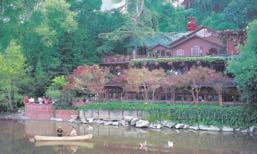
Visitors from all over love this fourth-generation, familyrun farm business that popularized the “pik-yor-self” experience just east of Watsonville’s Interlaken neighborhood. Tour the farm, pick fresh apples or berries or watch the action inside the juice-pressing barn. No one leaves hungry if they spend time at the bakery-deli that pleases with its fresh pies, shortcakes and pastries, along with hearty sandwiches and box lunches. This family friendly experience is also a treat for kids, who will enjoy the wide-open spaces and the homemade popsicles. Open daily 9am–5pm.
Staff of Life 906 E. Lake Avenue 831.726.0240 • staffoflifemarket.com
Opened last spring, Staff of Life’s second store in Watsonville is its first and only branch. The store is sustainable down to its bones and includes all the natural groceries, organic produce and baked goods you’d find at the Santa Cruz store, along with a juice and smoothie bar, freshly made sushi, a gelato bar, a full deli and a hot bar. Open daily 8am–8pm.
For a second, Anthony Vitacca seems like he can’t believe what he’s feeling.
“Look! I have goosebumps just thinking about this,” he says. “This is my thing! Creating, like a chef!”
He’s diving into how he designed his latest cocktail menu, how he’s planning an ice program and how much he’s enjoying reinventing Bar Napoli, formerly Vino, next to Little Napoli in Carmel.
“I can do this! I want to impress people!” he says. “No one is doing this in this town, and they’re definitely not doing it for happy hour.”
He’s all kinds of fired up— “Maybe I’m boasting, but I’m proud of what I do!”—but at the same time he appears more relaxed and happier than I can ever remember seeing him.
Barman Anthony Vitacca shakes up Carmel’s cocktail culture
 STORY AND PHOTO BY MARK C. ANDERSON
STORY AND PHOTO BY MARK C. ANDERSON
He agrees with the diagnosis and attributes his vibe to a range of things. He nods to the “system and structure” he learned from Downtown Dining group, working nearly two decades at Montrio Bistro. It’s a structure he is now applying to Bar Napoli, Little Napoli, Carmel Bakery, Vesuvio and its rooftop Star Bar. He acknowledges the benefits of working smarter (hello, batch cocktails) and not harder (less time making drinks so he can focus on big picture improvements). He talks about the foundation owners Rich and Sandra Pèpe have created, and their willingness to invest in infrastructure, tools and technology, at one point whipping out an imported Flavour Blaster Pro cocktail gun that makes giant bubbles of flavored vapor.
“We’re going to add some shelving,” he says, “so I can have more toys.”
Bar Napoli has had its liquor license for three years, but never identified as or presented as a bar, partly because it started as one of the city’s first wine tasting rooms, and still sells many retail bottles.
“A lot of people don’t know!” Pèpe says.
Vitacca’s leadership will change that. The 4–6pm Wednesday–Sunday happy hour, with $5.50 draft beers and well drinks, $6 wines and $7.50 craft cocktails, will draw plenty of attention too.
The happy hour drink menu pops with interesting ingredients and alchemy. I tried three new creations and each impressed, particularly the Miracles in Pairs (see recipe) and the bright, balanced and fresh Nonno Pèpe with Lunazul tequila, strawberry-infused PèpeCello,
smoked chili bitters and orange and lime juices.
Even the one that didn’t do it for me flavor-wise, the Carmel Cola, was remarkable in its composition. I mean, who summons an RC Cola profile from amaro, ginger beer and cherry bark bitters?
The happy hour food, meanwhile, leverages what Little Napoli does well. Items like saffron-risotto arancini, meatball lollipops and Tuscan white bean soup run $6, and pizzas like the white truffle are $13.
Vitacca comes as part of a transition that passes the Pèpe torch to Rich’s sons Christian and Gian, whom Vitacca will help mentor. Gian, who oversees much of the day-to-day operation, provides perspective on what Vitacca brings.
“People say he’s probably the best bartender on the Monterey Peninsula, but in addition to the bar skills, he’s provided a lot of leadership,” Gian says. “He’s a bit of a perfectionist, with high standards that are elevating our management team.
“We like him because he’s Italian too.”
Vitacca’s creation nods to a pair of twins who work for the family company, and the abiding spiritual belief that magic happens in tandem.
ounces Absolut pear vodka
ounce lavender-infused PèpeCello (limoncello)
ounce Lillet
dashes ginger bitters
ounce pineapple purée
ounce fresh lemon juice
Pour all ingredients into a cocktail shaker. Add ice. Shake, shake, shake. Double strain into martini glass. Garnish with dehydrated lemon slice. Makes 1 cocktail.

